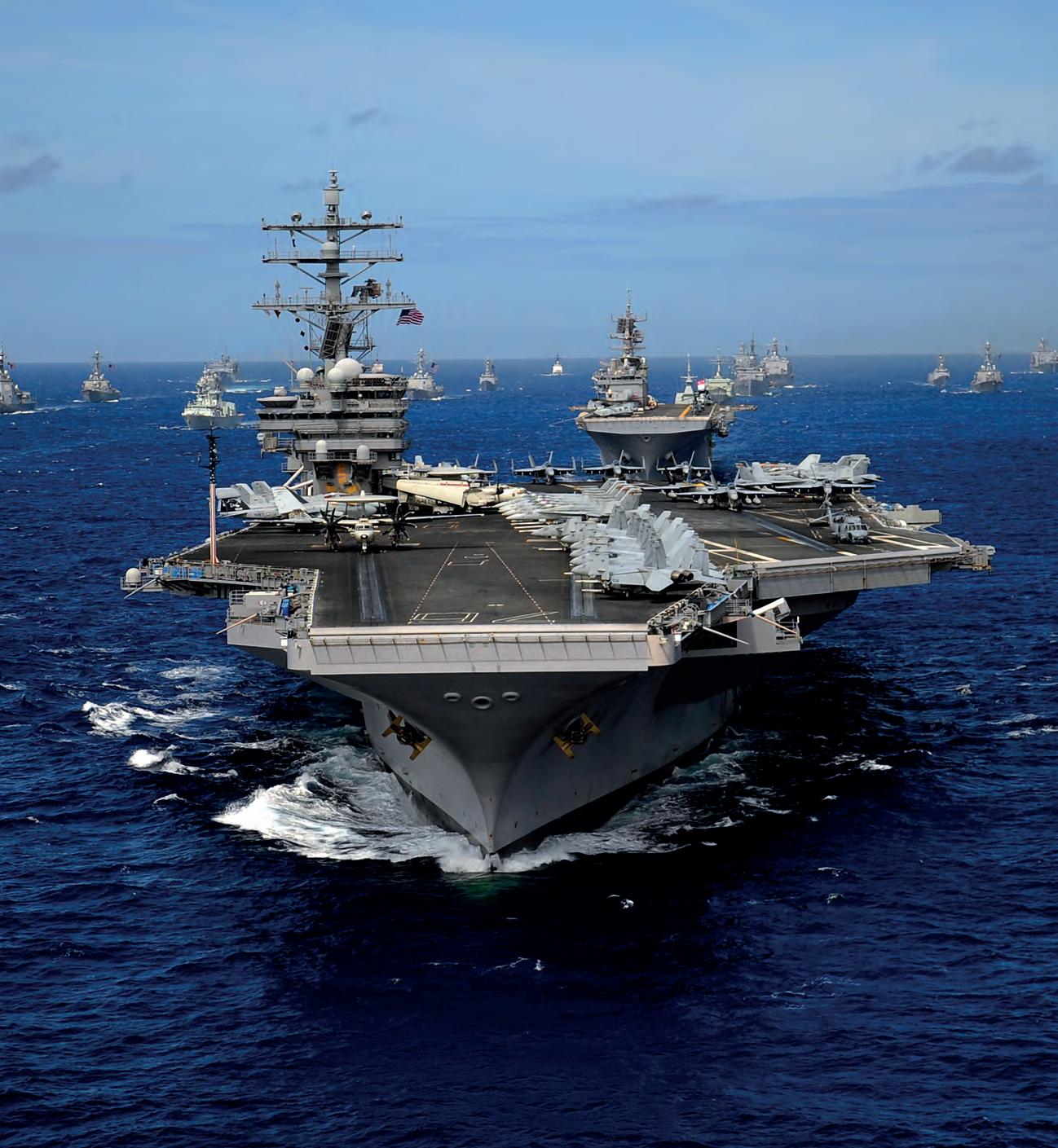

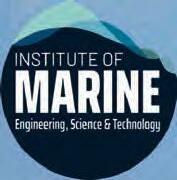








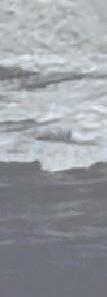















INSIDE: MARINE CYBERSECURITY / OCEAN MONITORING / EDUCATION IN OCEAN SCIENCE Issue 4 2022 Creating naval vessels that incorporate autonomy, fuel transition, connectivity and digitalisation DESIGNS FOR LIFE •



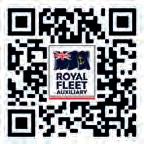
"" .'Ill ROYAL FLEET AUXILIARY
TheGreatBarrierReefisarguably oneofthemostwell-monitored marineecosystemsintheworld

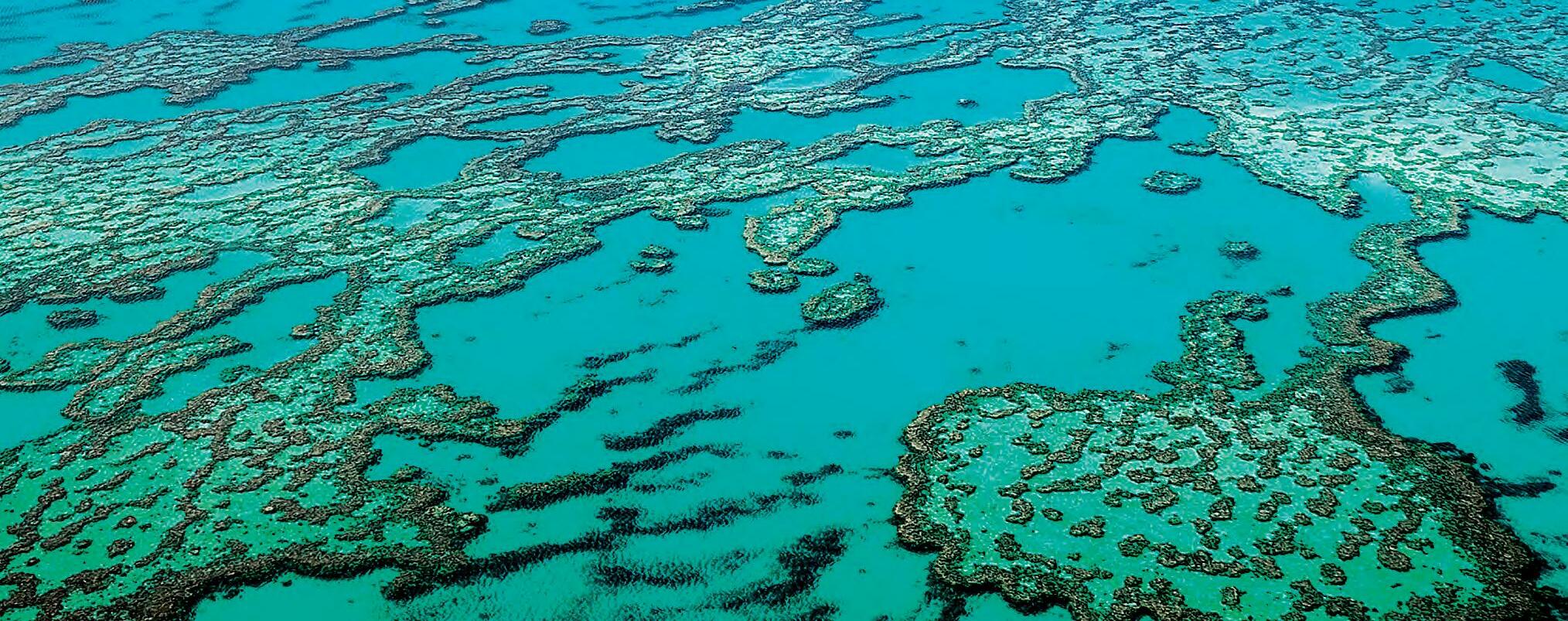

Foreword
TheIMarEST’snewstrategysets aspirationsandgivesaclearfocus forthenextthreeyears
IN DEPTH
Beneaththesurfaceof maritimeindustrytrends
7 Industrialmarineprojects
Strongpartnershipsand electrolyserswillpavetheway forhydrogen-basede-fuels
Greymatter
UtilisingVLCCsaswatercarriers
Troublespot
Incorrectferruleinstallationis toblameforfiredamage
Vesselfocus
Thefirstemissions-freepushertug
Influencers
Debate:globaldefenceleadingthe wayforsustainablenuclearpower inthecivilianmaritimesector
FEATURES
18 Navalinnovation
Designingnavalvesselswithfuel transition,autonomy,connectivity anddigitalisationallinmind
27 Digitalattacksandinsurance
Cybersecurity–asmarineassets arefallingvictimtomoreandmore cyberattacks,arepoliciesstarting tobecomeunviable?
30 Speakingthesamelanguage
Theimportanceofusinglanguage carefullytobeclearand‘coherent’ whendealingwithtoday’sships
Royalvessels
AlookatBritanniaandthedesigns ofroyalyachtsfromthepast
Marinemonitoring
Monitoringtheoceanwillhelp toprotecttheenvironmentand ecosystemresources
40 Seafarers’wellbeing
Howtodealwithmentalhealth issuesorbullyingandharassment whileatsea
44 Shippingcover
Willyourinsurancecoveryou fromdelaysarisingfromstorms?
Digitaltwins
Shipownerscangetthebest outofcreatingdigitalvessels
Zeroemissions
Isaholisticapproachfeasible forthedecarbonisationofthe maritimesector?
66 Thebigquestions
Q&A:George(Sandy)Thomson, founderofThordonBearings
INTERACTIONS
TheIMarEST’sshared knowledgehub
54 Oceanliteracyandawareness
Creatingpublicawarenessofthe marineenvironmentandfinding awaytoenticetoday’syouthinto thestudyofoceanscience
FellowQ&A
WithMikeWatt,IMarESTCouncil memberandBranchchair
59 Branchspotlight NorthEastCoastJointBranch
60 Managingmarinebiofouling
Shouldinternationalvesselsbe regularlyinspectedforthepresence of‘risk’biofouling?
Comment
Howtoattractnewanddiverse talentintothemarinesector
64YourInstitute
TheIMarESTMarineMammals SpecialInterestGroup’snewcareers guide;acallforawardassessors; plusmoreInstitutenews
SHUTTERSTOCK 3 MARINE PROFESSIONAL Issue4/2022 Issue42022 5
11
12
14
17
56
63
32
36
46
52
Contents
WELCOME TO

MARINE PROFESSIONAL
EDITORIAL TEAM
Editor
Carly Fields Art director
John Pender Managing editor

Rica Dearman
Client engagement director Anna Vassallo
ADVERTISING SALES

Michael Coulsey
020 3771 7232
michael.coulsey@thinkpublishing.co.uk
James Murdoch

020 3771 7198
james.murdoch@thinkpublishing.co.uk
Cyber risks are ramping up – of that there is no doubt. But how high can they go before they are simply too costly to insure? Cyber warfare is moving at a pace that the marine and maritime industries are struggling to keep up with. Where previously there might have been a clear rationale for an attack – government-owned facilities, attack against a hostile state and so on – there is now little obvious reason. In short, everyone and everything in our industry is a potential target.
From innocuous phishing attacks to cross-border, company-wide complete shutdowns, insurers are having to value an ever-harder-to-quantify risk. We report in this issue of Marine Professional of how insurance behemoth Lloyd’s of London has instructed its associates to start excluding Nation State cyberattacks from its insurance policies from the end of March 2023.
Marine Professional Think, 20 Mortimer Street, London W1T 3JW marineprofessional@thinkpublishing.co.uk 020 3771 7200

The industry’s raised profile through the pandemic has been lauded, but the darker side of that is that the sector has become more visible to cyberattackers. It has taken on a symbolic notoriety and proved how invaluable it is in keeping life ticking over, everywhere in the world.
We all need to improve our understanding of the threat of cyberattacks and of the available mitigation tools. If insurance can’t protect us, we have to tackle them head-on.
Carly Fields, editor

THIS ISSUE’S CONTRIBUTORS
any form or by any
without the prior
of the
IMarEST,
Institute of Marine Engineering, Science

Marine
does not necessarily

the views of the publisher or the Institute. While effort is made to ensure that the information is accurate, the publisher makes no representation or warrant, express or implied, as to the accuracy, completeness or correctness of such information. It accepts no responsibility whatsoever for any loss, damage or other liability arising from any use of this publication or the information which it contains.
Professor Dr Reza Ziarati FIMechE FIET FIMarEST is chair of the Centre for Factories of the Future.

Rear Admiral Nick Lambert FIMarEST is co-founder and director of NLA International, a blue economy solutions company.
Rajesh Madusudanan BE MSc FIMarE(I)
MIMarEST MRINA is a marine surveyor and consultant, based in India.

Sam Andrews is a marine ecologist, with a background working for government and private businesses.
Felicity Landon is an award-winning freelance journalist specialising in the ports, shipping, transport and logistics sectors.


Michael Grey MBE is an honorary IMarEST Fellow and a former editor-in-chief of Lloyd’s List.

4 MARINE PROFESSIONAL Issue 4/2022
CONTACT
FIND US ON SOCIAL MEDIA @IMarEST facebook.com/themarineprofessional youtube.com/imarest All rights reserved. No part of this publication may be reproduced, stored in a retrieval system, or transmitted in
means, electronic, mechanical, photocopying or otherwise,
permission
publisher. Copyright © 2022
The
and Technology. Information published in
Professional
represent
Cyber warfare is moving at a pace that the marine and maritime industries are struggling to keep up with
COVER IMAGE: GETTY IMAGES
•
Setting a clear path forward
BY GWYNNE LEWIS
Iam very pleased to announce that, together with the invaluable support of our Trustees, we have completed the work on the development of the Institute’s new strategy. This sets our aspirations and gives us a clear focus for the next three years.
Our vision for the IMarEST is as the trusted voice across the marine sector and as the global community for all marine professionals distinguished as leaders in shaping a sustainable world.
At the centre of this is a tailored membership experience that is accessible, valuable and relevant to all members across all marine professions at every stage of their career. To achieve this, we will continue working to ensure that members are able to support their ongoing professional development with access to active communities, such as our international Branches and Special Interest Groups, where you can share knowledge and experience, and drive change.
We will also continue to expand our partnerships with academia, industry and regulators across the globe, helping us to further raise professional standards and awareness.
Future planning
This is an exciting time as we step forward with our ambitious growth plan for the next three years. To this end, I would like to take the opportunity to welcome Hector Sewell, our sales and business development director. Since joining us, Hector has been busy getting to know us, providing valuable insight into our strategy, supporting our teams and exploring potential commercial opportunities for the Institute.
This year’s European International Submarine Races… was a showcase of innovation and engineering by students of all disciplines from around the world
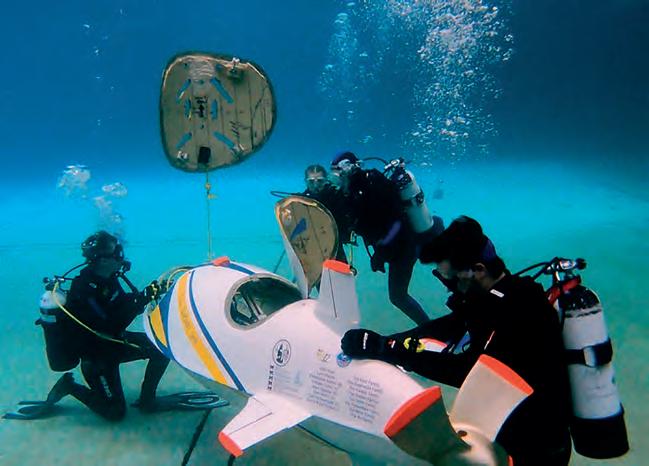
By responding to our surveys, you also provide us with insight, most recently into the many hopes and concerns you envision the marine sector faces in the short, medium and long term.
This was a question we asked in the last member survey and the team has spent some time analysing and interpreting more than 700 of your free text responses. You can read the full report on our website.
INEC Conference
Following on from the successful Annual Conference, we next have the ever-popular International Naval Engineering Conference and Exhibition (INEC), 8–10 November, incorporating the International Ship Control Systems Symposium (iSCSS). This year’s theme is adapting and innovating to build resilience for naval operations.
There are some fantastic speakers who will be talking about topics such as underwater noise, cybersecurity, naval decarbonisation, humanmachine teaming, next-generation submarine design and systems, and intelligent platform management, among other topics. It’s well worth attending if you haven’t before and there’s still time to register if you have not already done so.
Submarine races
Finally, I would like to thank the volunteers and judges involved in organising and running this year’s European International Submarine Races. These were held at the start of July in Europe’s largest freshwater research basin at QinetiQ’s Haslar Marine Technology Park, in Gosport.
The event was a showcase of innovation and engineering by students of all disciplines from around the world. A true inspiration and demonstration of the talented individuals who are the future of our sector.
Gwynne Lewis is CEO of the IMarEST.
5 MARINE PROFESSIONAL Issue 4/2022
FOREWORD
RYLAND BRYANT
The winners of the eISR 2022: HSRW Submarine-Team with Rivershark















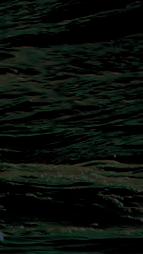
Hydrogen: if a job’s
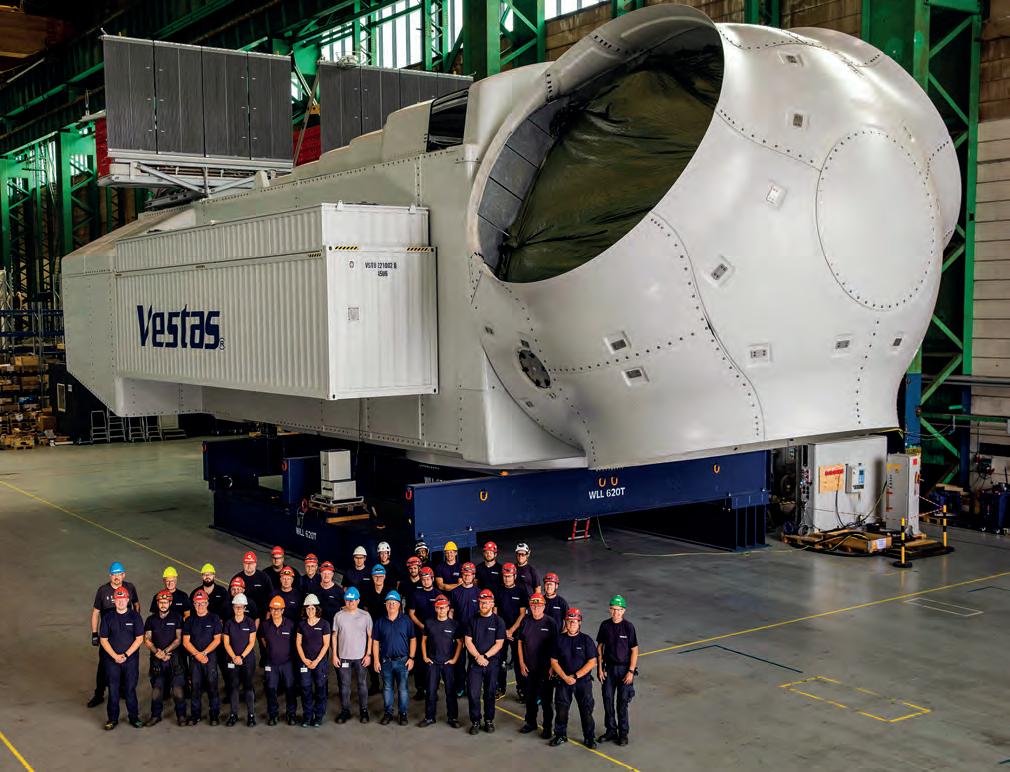 BY CHARLIE BARTLETT
BY CHARLIE BARTLETT

I nOctober1992,Toyotabegan atrickleofinvestmentin hydrogenfuelcells.Thetrickle wouldeventuallybecomeatorrent, speculatingontechnologythat hardlyexistedatthetime.
Toyotawantedtodevelop hydrogenintothenewpetrol, statingitsgoalofmeetingwith







7 Beneaththesurfaceofmaritimeindustrytrends MARINE PROFESSIONAL Issue4/2022
worth doing… Strongerpartnershipsandafocuson electrolyserswillbeneededtomake hydrogen-basede-fuelsavailableatscale Inthissection: 7Electrolysersandhydrogen-basede-fuels12Faultyferrulecausesshipflashfire 14Meettheworld’sfirstemissions-freetug17Globaldefenceandsustainablenuclearpower
VESTAS
Vestas unveils the world’s tallest and most powerful wind turbine. The wind power specialist sees great potential in combining wind power with electrolysers for green hydrogen production
>
California’s 1990 Zero-Emission Vehicle Program. The initiative seems absurdly progressive by today’s standards, dictating that 2% of all vehicles sold by 1998, 5% by 2001 and 10% by 2003 be zero emission. Three decades and billions in lobbying dollars spent later, and suffice it to say, they were not. Nor had hydrogen grown to become the fuel de rigueur.
Despite blazing a trail in electric cars with the Prius, Toyota took almost a quarter of a century to put a hydrogen car into production – the 2014 Mirai (‘future’, in Japanese). The reception was poor. It was noted that the car was more expensive even than an electric, which generally carry a premium over petrol cars; the amount of hardware needed made it weigh about the same as one, with comparable range; and there was nowhere to fill it up.
In the seven years since the Mirai’s release, Toyota and its customers have discovered that hydrogen is neither practical as a replacement for fossil fuels, nor as an alternative to electric cars. Its activities since have shown just how far the mighty have fallen; having developed one of the first, Toyota has since devoted exorbitant resources to lobbying against electric cars, including “sid[ing] with the Trump Administration in a battle with California over the Clean Air Act” – the legislation that pushed it to develop the Prius and Mirai in the first place.
“Despite positive top-line messaging on climate, [Toyota]… has consistently opposed regulatory efforts to increase the stringency of emissions and fuel economy standards for vehicles… globally… Toyota has been highly negative on policy mandating the electrification… promoting an extended role for hybrid vehicles and opposing the long-term phase-out of internal combustion enginepowered vehicles,” notes lobbying tracker InfluenceMap.
Problems in production

But Toyota is not alone in pushing hydrogen as a green panacea. It offers a tantalising promise for the fossil fuel industries as well: the possibility of exploiting coal, oil and gas deposits, and getting paid a fortune to refine them into hydrogen, before selling them at a price never likely to dip below double that of conventional oil and gas products.
The problem is the production chain. By the time hydrogen is used to fuel Toyota’s Mirai, its owner will be lucky to get 30% of the energy used to make that hydrogen (this compares to 70% for electric cars).
Speaking with Germany’s business magazine WirtschaftsWoche in 2019, Professor Maximilian Fichtner, deputy director of the Helmholtz Institute Ulm for Electrochemical
By the time hydrogen is used to fuel Toyota’s Mirai, its owner will be lucky to get 30% of the energy used to make that hydrogen
Energy Storage and designated expert in hydrogen research, applauded the then decision by Volkswagen to opt for batteryelectric drivetrains over hydrogen. He argued that the “very poor energy efficiency well-to-wheel” of fuel-cell cars rendered battery-electric “many times more efficient”.
“I am not at all opposed to hydrogen as an energy storage medium,” Professor Fichtner went on to say, “but you have to use it where it makes sense –and that’s not in cars, but in stationary applications.”
Now, even on the biggest ships, the prognosis is poor for hydrogen as fuel. It has generally been deemed too finicky and voluminous to store effectively, and shipping lines prefer to talk about using green methanol and green ammonia – both based on green hydrogen –as their zero-carbon fuels of choice.
At a panel on decarbonisation during the Hamburg SMM show, hosted by ABS, Maersk head of decarbonisation sustainability
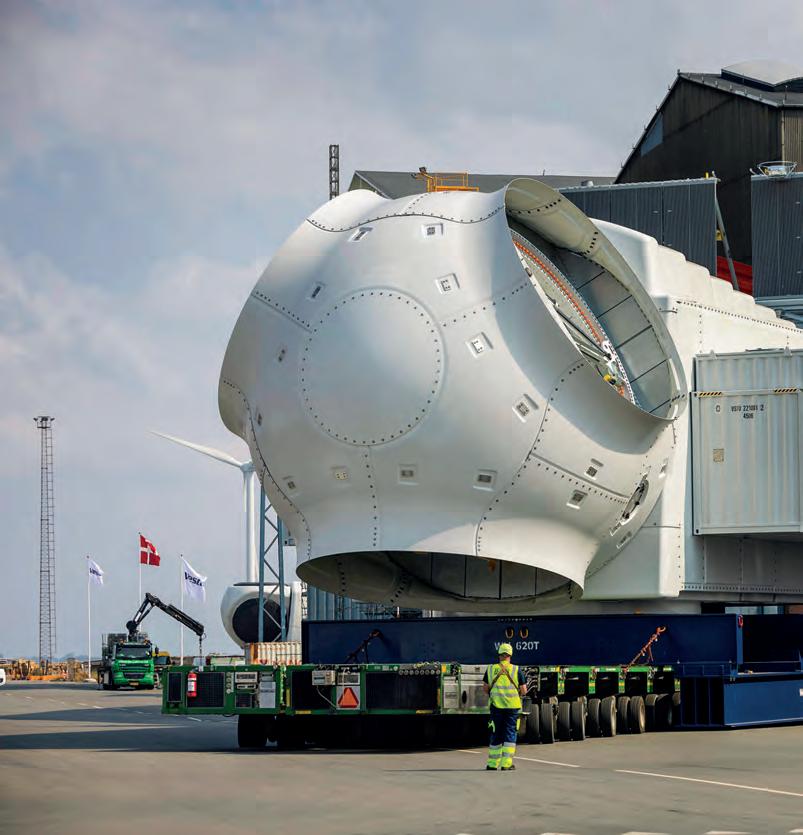
8 MARINE PROFESSIONAL Issue 4/2022
HYDROGEN
The manufacturer claims that Vestas’ 15MW prototype will generate 80GWh per year
VESTAS,
SIEMENS GAMESA
Ingrid Marie Vincent Andersen said that better scrutiny of well-to-wake dynamics would be needed if new hydrogen-based fuels are to gain traction – as well as a carbon tax.
“We definitely need market-based measures… to incentivise this.

“If you look at how ammonia and hydrogen are [currently] produced, they are actually worse for the climate,” Vincent Andersen said, in reference to steam reforming from fossil fuels. “It might be that some ship types can use hydrogen
as fuel, but it’s not going to be practical for larger ships. In the case of smaller ships, ferries, it might be practical. But there are some safety aspects of hydrogen that we have yet to understand.”

Experts seem to agree: hydrogen has many benefits, but these only seem to come into play when applied at scale. Fortunately, this is something the maritime and offshore industries know a thing or two about; the seas offer another chance to get it right.
Nuclear-by-proxy Few appear to be embracing this notion quite so enthusiastically as Core Power, which wants to bring nuclear energy back into the fold in climate discussions. The notion is a divisive one. In early August, reports emerged that Germany was looking to keep its last three nuclear reactors online over the winter. Together, these generate energy amounting to around 6% of the country’s power needs – down from 30% in 2011, the time of Japan’s Fukushima disaster.
Such is the opposition to nuclear power in Germany, in fact, that phasing out plants in favour of burning lignite coal – the filthiest available – is regarded as a step forward by green campaigners.
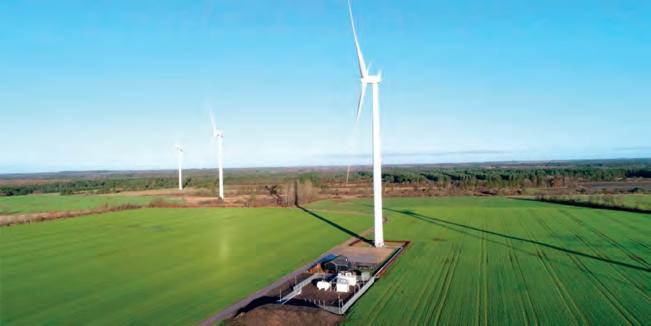
In late August, Germany’s economy minister, Robert Habeck, ruled out extending the life of the three plants: the “wrong decision… given how little [gas] we would save”.
But subsequently, the Russian Nord Stream 1 pipeline has been shut off “indefinitely”, due to “a leak”. At time of writing, European gas prices are entering fever pitch, and Chancellor Olaf Scholz has just announced a windfall tax and €65bn package to help households deal with rocketing prices. On the nuclear score, it is not yet known whether Germany will change its tune.
That environmentalists do not consider it to be ‘green’ at all flies in the face of consensus that it will be necessary to go nuclear. The United Nations Economic Commission for Europe executive secretary Olga Algayerova, speaking in 2021, said: “Nuclear power is an important source of low-carbon electricity and heat that can contribute to attaining carbon neutrality and hence help to mitigate climate change.”
Core Power says that the maritime arena is particularly advantageous for nuclear generation. Unlike on land where every powerplant is the first of its kind, shipyards could pump out endless series of modular reactors, it explains. “The experience of both Korea and China of repeatedly building the same reactor type… has shown that significant cost savings can be achieved by repeated construction of the same design,” says the company.
Locating on a floating production storage and offloading-like platform at sea also assuages factors “…including land cost, geological suitability and the potential opposition of local residents”, Core Power notes.
But in respect of using energy to generate hydrogen-based e-fuels, there is an even more compelling argument to be made. “Hightemperature electrolysis operates by changing the phase of water from liquid to superheated steam before feeding it to a solid oxide-containing
9 MARINE PROFESSIONAL Issue 4/2022
“Nuclear power is an important source of lowcarbon electricity and heat that can contribute to attaining carbon neutrality”
Siemens Gamesa’s turbine with built-in electrolyser
>
HYDROGEN
cell,”CorePowersays.“Inthisway, theenergyrequiredbytheprocess goesfrom100%electricalto85% electricaland15%thermal.”

Thisisvaluable,becauseheatis acrucialwasteproductofnuclear powerplants.Amaximumofaround 50%oftheheattheygeneratecan beusedtomakeelectricity;therest isbledoffbycoolingtowers.Butin theproductionchainofammonia generatedfromseawater,various steps,includingdesalinationand theHaber-Boschprocess,happen torequireinputsofheat.Thiswould furtherincreasenuclear’salreadyimpressivecapacityfactor.
Thebottleneck
Electrolyserswillbealimiting factorinthedevelopmentofthe hydrogeneconomy,withjust47GW ofannualproductioncapacitylikely tobeonlineby2030,accordingto USinvestmentbankJefferies.Proton exchangemembraneelectrolysers aremadefromexpensivematerials suchastitanium,iridiumand platinum,whicharealimiting factorforthehydrogeneconomy. However,expertssaythesemore expensiveelectrolysersarebetter abletodealwithfluctuationsin powergeneration,makingthem abetterbetforvariableproduction turbineslikewind.
Butinarecentreportentitled WorldEnergyTransitionsOutlook 2022,theInternationalRenewable EnergyAgency(IRENA)pointedout thatsolarinstallationshadfallen inpriceby82%between2010and 2019thankstoimprovementsin production.Itisnotunreasonable toexpectthesameofelectrolysers onceproductionhasrampedup. “Asimilardecline[incost]is expectedforelectrolysersinthe comingdecade,thankstothe largepipelineofgreenhydrogen projects,”IRENAsaid.
Atleast1GWofelectrolyser productioncapacityiscurrently underdevelopmentintheUS.Here, HornblowerEnergy,asubsidiaryof cruisecompanyHornblowerGroup, hasgarneredan$8mgrantfrom
theUSDepartmentofEnergyfora floatinghydrogenrefuellingstation.
Expectedtobeupandrunning by2025,theelectrolyserwillbeused torefuelHornblowerGroup’sown vesselsaswellasfeedhydrogen intotherestofNorthAmericafor otheruses.
“WithHornblowerGroup’slongstandingenvironmentalrecordof developingwaysandresourcesto implementgreenpractices,Iam incrediblyproudoftheworkour teamhasputforwardinleading thisnextphaseofhydrogen-fuelled technology,”saysKevinRabbitt, HornblowerGroupCEO.
Atimeofblades
Windturbinesaregettinglarge. A15MWprototype,calledtheV236, iscurrentlyunderconstructionat VestasWindSystems’Lindøplant, andwillgenerate80GWhperyear, themanufacturerclaims,onceit isinstalledoffDenmark.Itsblade spanwillbemorethanaquarter ofakilometreacross.
Currently,rivalSiemensGamesa isworkingonitsownlargest turbine,theSG14-222DD,witha nominalpowerof14MW.Butthe stemoftheturbineissovoluminous thatSiemensGamesahascomeup withacompellinguseforit.Inside thebodywillbeanelectrolyserunit, whichdesalinatesseawaterand, usingelectrolysis,convertsitinto
hydrogen.Thisisbeingcalled‘island mode’,becauseitallowstheturbine togenerateusableenergywithout anyconnectiontotheshore.
SiemensGamesaestimates thatsome5.5TWhofelectricity production–enoughtorunallthe UK’selectricityforsixdays–isleft onthetableeveryyearthanksto curtailment,thewastedenergy whenwindisnotused.Itisnot possibletostretchanundersea cabletoeverywherethatiswindy. Thesolution,thecompanysays, istouseanelectrolysertogenerate hydrogenallthetime.
IncombinationwithSiemens Energy,SiemensGamesaplansto spend€120montheprojectover thenextfiveyears.Theformeralso recentlyannouncedapartnership withAirLiquide,toestablisha newfacility,whichwouldimprove theglobalproductioncapacity forelectrolysers.TheSiemens/Air Liquidejointventureestimatesthe Berlinfactorywillhaverampedup to3GWannuallyby2025.

“Tomakegreenhydrogen competitive,weneedserially produced,low-cost,scalable electrolysers.Wealsoneedstrong partnerships,”SiemensEnergy chiefexecutiveChristianBruch says.“Wewanttobeadriving forceinhydrogentechnology.”
FIND OUT MORE
Formoreinformationon hydrogeninfrastructure developments,visitIMarESTTV.
10 MARINE PROFESSIONAL Issue4/2022
CHARLIE BARTLETT
“Tomakegreenhydrogen competitive,weneedserially produced,low-cost,scalable electrolysers.Wealsoneed strongpartnerships”
On an ABS-hosted panel at SMM, Maersk’s Ingrid Marie Vincent Andersen (seated far right) said that better scrutiny of well-to-wake dynamics would be needed if new hydrogen-based fuels are to gain traction
/ ----. ----...-. ,.Jl1j. 7 -
The trouble with water
BY MICHAEL GREY
Water.It’sgrandforsailingon, butthereiseithertoomuchor toolittleofit,anditistoooftenin thewrongplace.Therearefloodsin somepartsoftheworldanddroughts inothers,whileimportantrivers liketheRhinearesolowthatthe inlandtradetoseveralmajornations ismenaced.Andwhileweblame climatechange,populationgrowth, deforestationandthenaturalcycles ofweatherfortheseevents,weought toconsiderwhatcanbedoneto mitigatetheseextremes.
Mightshipshaveanopportunity here?Thereiscertainlyarolefor shipsincarryingwateraround: witnesstheregularfresh-water deliveriesfromthemainlandto parchedGreekislands,where droughtisbothseasonaland endemic.Itmightberecalledthat duringpoliticaldisagreements betweentheUKandSpain,clean producttankerswereregularly usedtosupplytheinhabitantsof Gibraltarwithwaterfromthenorth. Eventually,thepoliticalclimate easedandbetterwaterstorage facilitieswereconstructedonthe Rock.Butasanemergencymeasure, cleantankerscanbeveryuseful.
Andattimeswhenthecharterrates arecheap–notaltogetherunknown inthisvolatilesector–itcanbean economicmeasurewhentherain doesn’tfall.
Giantwatercarriers
Inthe1970s,whentherewere watershortagesinmanyparts oftheworld–thiscoinciding withadesperateoversupply ofbigtankersafterthe‘oilshocks’ –therewereseriousstudies undertakentoconvertVLCCs asgiantwatercarriers.There weretankersinlay-up,which

hadnevercarriedacargoof hydrocarbonsandwhoseowners, itwasassumed,wouldleapatthe chanceofanyemploymentsfor thesefinancialmillstones.And someyearslater,therewasresearch donetodeterminethefeasibility ofconverting‘used’VLCCsinto apermanentwater-carryingrole. Thiswouldinvolveamassive hold-cleaningoperationandthe replacementofthecargoandinert gaslineswithasimplifiedcargo pipingsystemusing‘plastic’cargo lines,whichwouldbecorrosionproofandeasytokeepclean.
Oneschemethatappearedto goratherfurtherthansomewas aprojectthatwouldsupplywater sourcedfromthepristinefjords ofNewZealand’sSouthlandona regularbasistotheparchedusers ofCalifornia,whocouldobviously paythecostofhaulingitacross thePacificinafleetofscrubbedupVLCCs.Politicaland environmentalobjections,which
rangedfromsafetyconcerns toMāorirights,squashedthis water-transportscheme.
Alsointhe1970s,when oil-drivendevelopmentinthe Arabianpeninsularwasprovoking increasingconcernsaboutthe provisionoffreshwaterinthese growingcentres,therewasan interestingschemeproposedtotow AntarcticicebergsupintotheGulf, usingfleetsofpowerfulsalvage tugs.Intheory,itseemedfeasible –ifsufficienthorsepowercouldbe summoned–despitethesehuge tabularbergsmeltingfastonce theywereintropicalwaters.There hadalreadybeeninstanceswhere powerfulanchorhandlershadbeen employedtotowmenacingArctic bergsclearofoilinstallationsin Canadianwaters.

Divertingtabularicebergs

Morerecently,duringaprolonged droughtinSouthAfrica,therewere rathermoreconcreteproposals byateamofveryexperienced salvageexpertstoharnessacalving Antarcticicebergandtowitinto ananchorageclosetoCapeTown. Usingthepowerofthewindsand currents,itwascalculatedthat thetabularicebergonlyhadtobe divertedashortdistancenorthward fromitsnaturalpathinthegreat eastwarddrifttogroundoffthe drought-strickencoastline,where itsfreshwatercouldbe‘harvested’.
Sadly,perhaps,therewasalways somereasonwhytheseschemes neverreachedfruition.Maybethe rainscame,astheyinvariablydo, ormorelikelythereweremajor advancesmadeinthedesalination sector,whichmadefreshwater fromtheseacheaperandmore practical.Butitisworth rememberingthatships,asalast resort,aregenerallyavailable.
11 MARINE PROFESSIONAL Issue4/2022 GREY MATTER
MichaelGreyMBE isanhonorary IMarESTFellow andaformer editor‑in‑chief ofLloyd’sList.
VLCCshavebeenputforwardassuitablewatercarriersmorethanonce
Could VLCCs
be the solution to transporting fresh water? DEV VARUN VIA SHUTTERSTOCK
Faulty repair causes major fire
 BY JOHN BARNES
BY JOHN BARNES
On 28 April 2021, around 0154 local time, the 7,831 TEU container ship President Eisenhower, owned by American President Line (now part of CMA CGM) and built by Hyundai Heavy Industries (HHI) in 2005, was transiting westbound through the Santa Barbara Channel. About 17 miles southwest of Santa Barbara, California, the vessel experienced an engine room fire. The crew fought it using fire hoses and a fixed water mist system, before using the engine room’s fixed CO2 fire-extinguishing system, which extinguished the fire.

The vessel lost propulsion and drifted for several hours before being towed to the Port of Los Angeles. No pollution or injuries to the crew were reported, but damage to the vessel was estimated at $8.22m.
Most of the fire damage was to the main engine, a 69,440kW MAN B&W 12K 98 MC-C manufactured by HHI, specifically from the cam shaft
deck upwards and was concentrated between cylinder 3 and 7, with 4, 5 and 6 experiencing the most.
Repair to pinhole leak

After the fire, investigators from America’s National Transportation Safety Board (NTSB) discovered that on the morning of 27 April, before the vessel’s departure, a new section of 17.3mm diameter steel fuel oil return tubing for the main engine was installed by the second engineer on the number 5 cylinder.
Two months previously, the section had developed a pinhole leak and had been patched until new tubing could be procured. The section of tubing in question had been fitted in the shipyard during construction of the vessel and was not available from the
engine manufacturer as an original equipment manufacturer part.

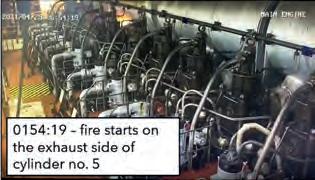


The new tubing was sourced locally and professionally bent by a shoreside fabrication shop to match the existing tubing. The new tubing was connected to the existing fuel oil return tubing using a compression fitting on each end.
Because the new section of tubing did not come with compression fittings attached, new fittings – specifically a ferrule and compression nut for each end of the tubing – had to be used by the engine crew to complete the installation.
12 MARINE PROFESSIONAL Issue 4/2022
TROUBLESPOT SHEILA FITZGERALD VIA SHUTTERSTOCK
No pollution or injuries to the crew were reported, but damage to the vessel was estimated at $8.22m Damages ran into the millions of dollars for the incorrect installation of a compression-fitting ferrule FIGURE 1: Cross-sectional diagram of typical compression fitting and body FIGURE 3: 0124:00 – Fuel spray visible on CCTV around cylinder no. 5 FIGURE 4: 0154:19 – Fire starts on the exhaust side of cylinder no. 5 FIGURE 5: 0155:19 – Fire growth after one minute FIGURE 2: Properly swaged ferrule on the PresidentEisenhower’s old section of fuel oil return tubingFittingFerruleNutTube PORTO -=:=:;,..=====::::;;;::;::=::: ~~-,.:;;:. PORTOF O lhLl~ll
Faulty ferrule and non-existent insulation
A post-casualty examination of the vessel showed the newly installed fuel oil return tubing for the number 5 cylinder had completely disconnected from the body of the compression fitting closest to the cylinder cover. The compression nut for the fitting was able to be loosened by hand, and the ferrule was not swaged onto the tubing. In addition, an engine exhaust compensator flange for the cylinder, which was about 1.2m away from the separated tubing, was not insulated or shielded by sheet metal.
Main engine data indicated that at similar engine loads as when the fire started, exhaust gas temperatures reached about 315°C. After the fire, the engine manufacturer determined that the fire had started when fuel oil from the disconnected return tubing on the number 5 cylinder sprayed onto the exposed surface of a flange for the exhaust valve compensator.
The service report completed by the manufacturer also indicated that the “insulation for the exhaust compensator flanges for all cylinder units was found insufficient and sheet metal not covering the

SHIP DETAILS
The President Eisenhower is a 7,831 TEU containership. It is owned by American President Line (now part of CMA CGM) and was built by Hyundai Heavy Industries.

flanges”. The report concluded that “all surfaces with a temperature above 220°C [have] to be properly insulated” and the reason for the disconnected fuel return tubing on cylinder number 5 was “likely due to incorrect assembly in way of insufficient tightening” of the compression fitting, or the “ferrule was not mounted correctly, i.e. the pipe was not fully inserted through the steel ferrule at tightening”.
Conclusions
The NTSB report into the incident concluded that the probable cause of the engine room fire was a crewmember insufficiently swaging a compression fitting ferrule during the installation of the fuel oil return tubing for the main engine’s cylinder, allowing an end of the tubing to disconnect and spray fuel oil onto a nearby unshielded and uninsulated cylinder exhaust component.
A representative from the engine manufacturer determined that this was likely due to incorrect tightening of the compression fitting, or the ferrule was mounted
incorrectly – in essence, the pipe was not fully inserted through the ferrule at tightening. The second engineer, who had never completed an installation in which a new compression fitting ferrule needed to be installed onto steel tubing, acknowledged having difficulties while completing the installation.
The NTSB noted two related accidents. On 8 December 2015, an engine room fire broke out aboard the containership Gunde Maersk near Seattle, Washington. The probable cause of the fire was “an improperly installed fitting on a fuel line supplying a fuel injector pump for auxiliary engine number 1”.
On 16 January 2017, the vehicle carrier Alliance St. Louis was under way in the Gulf of Mexico when a pipe plug on the fuel pump for the main engine’s number 6 cylinder came loose, resulting in fuel spraying onto the engine’s hot exhaust manifold, and the atomised fuel quickly ignited. Probable cause of the fire was “improper tightening of a pipe plug on the top cover of the number 6 cylinder fuel pump housing”.
The author also recalls an engine room fire aboard the stern trawler C. S. Forester in 1970. An engineer was replacing a lube oil filter, which required flow to be switched from one filter to the adjacent unit. Unfortunately, it was not clear which way the oil was flowing, and on removal of the filter it proved to be the one that was open, and immediately oil sprayed over the main engine exhaust piping. A flash fire broke out, the engine room evacuated, sealed and CO2 injected, but before the fire had been extinguished, it had almost reached the bridge. As a result, the vessel had to be towed to Hull.
13 MARINE PROFESSIONAL Issue 4/2022
The NTSB report into the incident concluded that the probable cause of the engine room fire was a crewmember insufficiently swaging a compression fitting ferrule
World’s first emissionsfree pusher tug
BY RAJESH MADUSUDANAN
Elektra, the now in-service world’s first emissions-free pusher tug, started life in a German consortium led by Gerd Holbach, a professor at Technischen Universität Berlin (TU Berlin) and Berliner Hafenund Lagerhausgesellschaft mbH (BEHALA). Holbach brought the project partners together based on preference, experience and capability to fulfil the goals set for the project, which started in earnest in 2017.
The Elektra project is based on the National Innovation Program, National Organisation Hydrogen and Fuel Cell Technology (NOW), Design and Operation of Maritime
Systems at TU Berlin and BEHALA.
At a total cost of approximately $14.2m (€13m), the Federal Ministry of Transport and Digital Infrastructure has contributed approximately $8.85m (€8m), while the Projektträger Jülich and NOW have also made contributions.
Elektra is designed to push a cargo barge, Ursus, developed by the design and operation of maritime systems department at TU Berlin, and numerous other cargo boats. Expect to see Elektra transporting many goods on the Berlin to Hamburg and inner-city

routes in Berlin. However, the most important transportation task of Elektra will be carrying Siemens turbines, which need to be shipped from a production site in the centre of Berlin to the Western Harbour or to Hamburg.
Maritime battery supplier ESTFloattech joined the partnership in 2018. The basis of the newly developed hybrid system is the battery package, consisting of 242 DNV-approved GO1050 modules with a total capacity of 2.5MWh, delivered by EST-Floattech, as well as three maritime fuel cell systems

Elektra is designed to push a cargo barge, Ursus, developed by the design and operation of maritime systems department at TU Berlin, and numerous other cargo boats

MARINE PROFESSIONAL Issue 4/202214
The flagship Elektra project features a hybrid system consisting of a hydrogen energy source and a battery system
VESSEL FOCUS
Hydrogen inland barge Elektrais the world’s first emissions-free pusher tug
EST-FLOATTECH
(NT-PEMFC, 100kW peak power each). Although the power of the battery and the fuel cells will be used together to power the electric motors, for complete redundancy the two powertrains are entirely independent systems.
Features and capabilities
Elektra will deliver an electric power capacity of 21,200kWh for a round trip from Berlin to Hamburg. Running on hydrogen, Elektra will be able to travel a minimum of 62 miles over a 16-hour day, or longer. “We have arranged for on-board and remote monitoring of the installation so everyone can check the performance,” says Diederick Stam, founder of EST-Floattech.
The energy storage system delivered has a range of integrated safety features. Its unique active balancing and passive safety system is applied at the module and string level. Heat is dissipated by a simple off-the-shelf aircon unit. The battery racks can easily be installed in a modular fashion.

Elektra is equipped with two SCHOTTEL rudder propellers type SRP 100 with nozzle (200kW each) and a SCHOTTEL steering and control system. A minimum service speed of maximum 10km/h can be reached and a maximum thrust load of 1,400 tonnes is available.
The vessel uses the fuel cell technology for the basic energy supply of the powertrain and for the shipboard electrical system. At peak loads, additional energy is provided by the batteries. The hydrogen supplied to the fuel cell is generated via electrolysis from green electricity generated by wind power. The vessel is intended to maximise the use of energy carried on-board.
VESSEL PARTICULARS – HYDROGEN CANAL TUG ELEKTRA

Length (m): 20
Breadth (m): 8.2
Draft (m): 1.25

Capacity: 2.5MWh Country: Germany
Type of vessel: Hydrogen inland barge Battery solution: Green Orca 1050 Certification: DNV Application: Hydrogen fuel cells
In addition to propulsion, the hydrogen power system provides heating for the cabins and the wheelhouse. The waste heat from the fuel cells is used through continuous water cooling and the cabins are warmed by a heat pump.
Proof that it is possible
“Elektra’s unique feature is its new energy system,” says Holbach. “Elektra itself is merely the system carrier. At present, inland shipping is not, on the whole, CO2 neutral. This energy system is ideal for built-up areas in particular, as it is emissions-free and guarantees noise protection. The idea of using hydrogen as a fuel was developed as far back as the 1960s. Hyundai and H2 Energy are preparing the world’s first fleet of 1,000 fuel cell commercial vehicles, which will hit the streets of Switzerland as of 2019. Yet when it comes to freight traffic, Elektra is a flagship project. This was all about proving that it is possible.
“The investment costs are significantly higher than for comparable conventional push boats. The goal, however, is to achieve an efficiency in terms of operating costs like that seen with diesel drive technology. Yet, we can also put other aspects into the balance here: an additional use, which is not immediately obvious is also conceivable. Elektra could function as an electricity supplier for a district, i.e. as a mobile power plant; the notion of integrated energy springs to mind here – comprising heat, energy and mobility,” he added.
As Elektra is the first zeroemissions push boat, based on a hybrid system consisting of a hydrogen energy source and a battery system, it is a pioneer. This technology can be used on different kinds of maritime vessels that want to sail with zero emissions.
MARINE PROFESSIONAL Issue 4/2022 15
Rajesh Madusudanan BE MSc FIMarE(I) MIMarEST MRINA is a marine consultant, based in India.
“The investment costs are significantly higher than for comparable conventional push boats. The goal, however, is to achieve an efficiency in terms of operating costs like that seen with diesel drive technology”
Elektramoving through Berlin’s Western Harbour, the city’s largest inland port


FullyfundedstudentplacesavailableforSeptember2023 An awardwinning,jointlyawarded,EngineeringDoctorate(EngD)in OffshoreRenewableEnergy. IOCOREprovidesbespoketraininginthe engineering,economicandenvironmental aspectsof offshorewind,waveandtidalenergyandathreeyear,industrybased, researchproject. Toapplyfor a placeorto sponsora projectpleasevisit:www.idcore.ac.uk UNIVERSITY OF ETER THE UNIVERSITY efEDINBURGH Engineering and Physical Sciences ..._...._ _ _j Research Council Universityof. Strathclyde Glasgow ~SAMS Natural Environment Research Council
Should global defence lead the way for sustainable nuclear power in the civilian maritime sector?
 RichardPerryCEngFIMarEST chiefengineer,Atkins–memberoftheSNC-LavalinGroup
RichardPerryCEngFIMarEST chiefengineer,Atkins–memberoftheSNC-LavalinGroup

Myviewisthattheanswerisno,unless directedtodoso–andfundedtodoso –byoneormoreNationStates.It’snot theroleof‘defence’todoanythingina civilianandcommercialcontextunless anationdecidesthatthatactivityforms partofitssecurity,anddefenceneedsandexpressesthat throughanappropriatecascadeofstrategy,policyand plans.I’mputtingthisviewforwardasaformernuclear submarinerwhonowworksinboththecivilanddefence nucleararenas,andwithsomeexperienceinboth sectorsofoperationsandregulation,andthepeople capability.Maritimebusinessesneedtomanagetheir ownbusinesstodeliverfortheirownshareholders.
RSingh viaemail

No,notnecessarily–itdependsontheapplication. Ifitisship/submarinevesselpropulsion/powerfocused,thentherewillbeadirectlink,butifit island-based,thecivilnuclearsectorshouldlead. Therewillbesometechnologytransferpotential, forexample,smallmodularreactorswithsimilar companiesinvolved.Thereisalsoadangerofloss ofpersonnelweredefenceauthoritiestogetinvolved incivilnuclear,whichisofcoursegenerallyoutside theirremitandscope.
SFlynn viaemail
Nuclearpowerhasbeenusedonmainlynavalvessels safelyformanyyears,therefore,thetechnologyis mature,especiallyastheplantsarerelativelysmall. Thiscouldbetransferredtothecivilsector.The problems,Isuspect,arepublicperceptionand probablythedesireofthemilitarysectornottotransfer technology.Togetherwithrenewables,nuclearwould beagreatwayofbecomingself-reliantforenergy withouttheproblemsassociatedwithhydrocarbons.
NEXT ISSUE’S QUESTION
“Whydosofewunderstandwhatbeing ʻcarbonneutralʼreallymeans?”
Ifyouwouldliketocontribute,please
email marineprofessional@thinkpublishing.co.uk
“Myviewisthattheanswerisno…It’s nottheroleof‘defence’todoanything inacivilianandcommercialcontext unlessanationdecidesthatthatactivity formspartofitssecurity,anddefence needsandexpressesthatthrough anappropriatecascadeofstrategy, policyandplans”
Richard Perry, Atkins
MARIUSZ NIEDZWIEDZKI 17 MARINE PROFESSIONAL Issue4/2022 INFLUENCERS W' ,
A question of survivability
BY FELICITY LANDON
Autonomy, fuel transition, connectivity, digitalisation – the world’s shipowners and shipbuilders have huge decisions to make in terms of designing vessels fit for the future. For naval ships, choosing and taking the right path involves additional layers of challenge. Which fuel would be safest in
a conflict situation? Which fuel is going to be available wherever the vessel needs to refuel? How can more autonomy be achieved, and what are the risks?
First, let’s set the scene. Naval vessels are not constantly involved in conflict – their roles can vary from coastal patrol and fisheries protection duties to diplomatic visits. Thomas Beard, senior analysis

engineer at BMT, points out: “Ninety to 95% of the time, a naval vessel is operating in peacetime and doing other things. It is very rare that we see a naval battle these days, and Ukraine has been the first in a long time. Otherwise, apart from issues in the Gulf, the last from within NATO was the UK in the Falklands.”
However, he warns: “As mostly it is about peacetime operations, and if
18 MARINE PROFESSIONAL Issue 4/2022
How a country defines survivability informs how it reacts to design questions on fuel transition and autonomy
NAVAL INNOVATION
you haven’t been in battle for so long, maybe you think you don’t need to worry about survivability, etc.”
Each nation deems survivability differently, he says – some prioritise protecting vessel and crew and “staying in the fight”, while others may take the view “as long as we can get away”.
“Hence, there are differences in acceptable risks – for example,
where ammunition is stored. It will be the same with the use of any alternative fuel on a ship.”

Any alternative fuel to be used on-board will be either highly flammable and explosive or highly toxic, says Beard, who leads at BMT on future fuel capability and integration of any alternative fuels into ships. “Hydrogen, methanol, methane, LNG are highly flammable.
Ammonia is highly toxic. All come with different nuances. We can design for that.”
His view is that it is easier to mitigate and design for an explosive material than for something that is toxic. As he says, naval vessels are designed “for getting shot at” and to carry explosives on-board. Many are designed for conditions of chemical, biological and radiological warfare.
19 MARINE PROFESSIONAL Issue 4/2022
GRINDSTONE MEDIA GROUP VIA SHUTTERSTOCK >
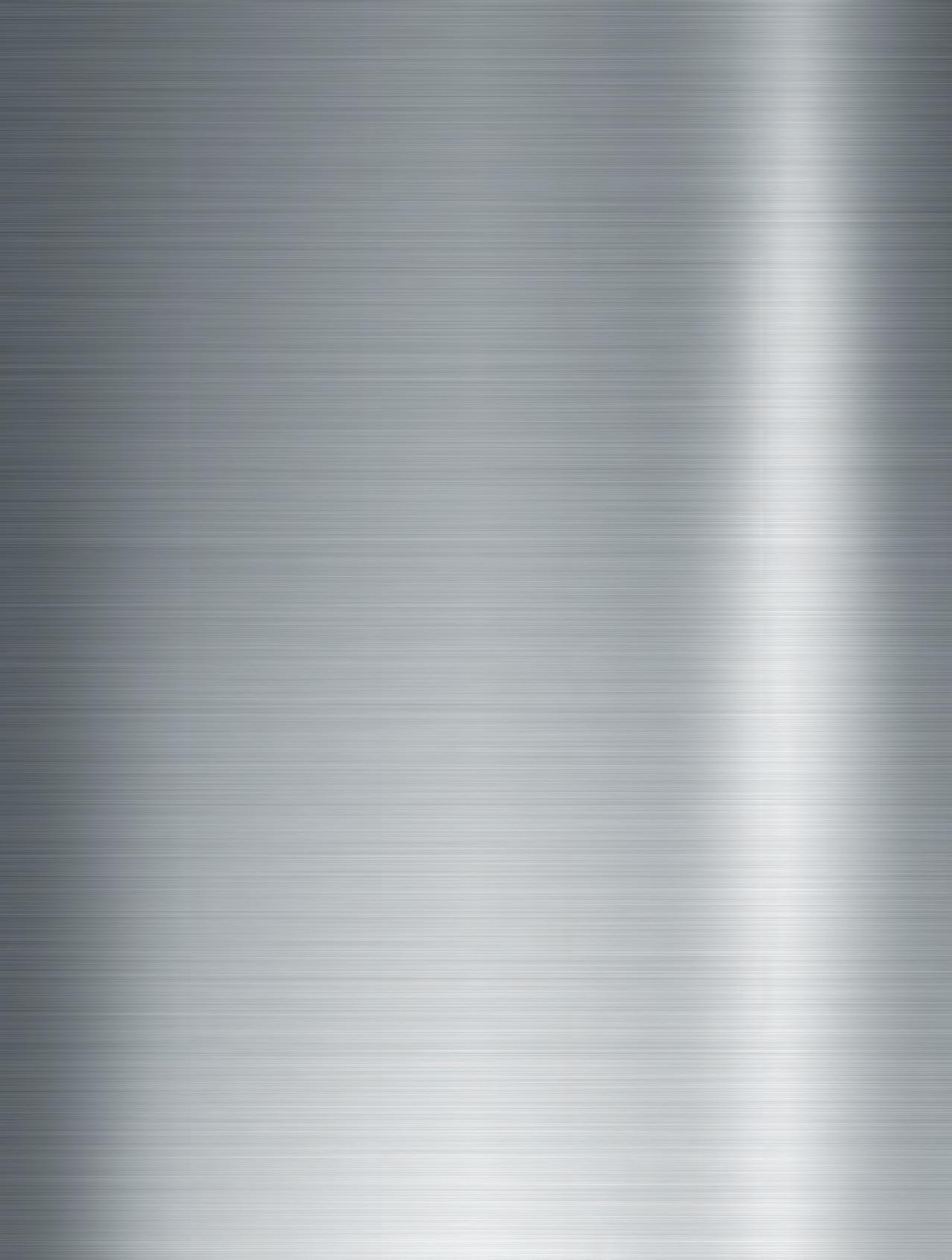





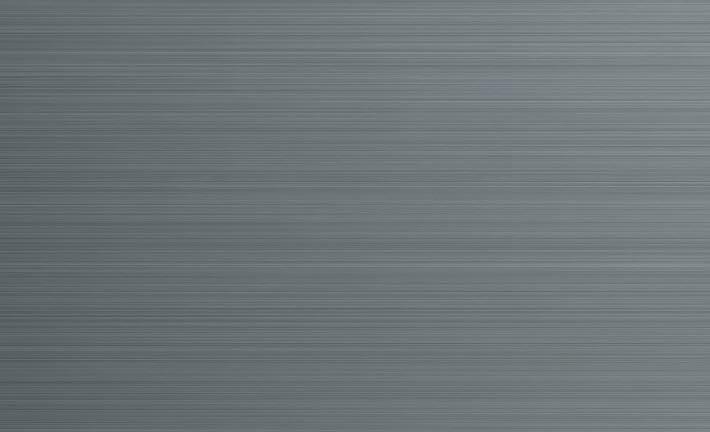

































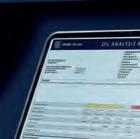


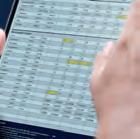









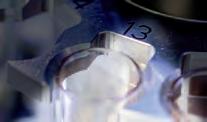













45 Y[EARS Of WORLD CLASS LABORATORY ANALYSIS For over 45 years Spectro I Jet-Core hos been the laboratory of choice for discerning vessel operators where delay due to machinery breakdown is not on option. For them there is only one choice the best Spectro I Jet-Core. World-Closs laboratories accredited to the highest international standards, the latest in laboratory equipment and highly qualified staff who understand marine engineering and the challenges that are ever present. To be the best you need the best support. Experience our experience. There's none better. Period. Our technical team will be at SMM Find us at Beath #Bl .OG.302, Hall Bl Upper Floor in the British Pavilion. spedro-oil.com I jet-care.com SPECTRO I JET-CARE Odiham I Hampshire I UK T +44 (0) 1256 704000 JET-CARE Cedar Knolls I NJ I USA T + 1 973 292 9597 SPECTROOIL AG Kaiseraugst I Switzerland T +41 (0) 6181590 20 'Spedro' and 'Jet-Core' ore registered trademarks and used under licence by Spedro Oil AG and Jet-Care lntemationol Inc. Copyright© Palace International Ltd. 2022
“Ifyouhavebeenhitandyou arecarryingsomethingexplosive, theremightbeabiggerexplosion thanwouldotherwisehavebeen–butthatisit.Ifyouaredealing withatoxicfuel,youarefighting fireandalsosomethingtoxic–youcan’tjustspraywaterat ammonia,youhavetokeep wateraway,”saysBeard.
Mostnavalvesselshavebuilt-in redundancyandsegregation,he adds–forexample,havingmultiple engineroomsandseparatelylocated dieselgenerators.Thatmeansaship couldkeeppowerandpropulsion evenafterbeinghit.Dealingwith atoxicmaterialwouldhavemuch morecompleximplications.
Designdecisions
JakeRigby,researchand developmentleadatBMT,saysa warshipwouldbefarmorecapable ofdealingwithsuchanincident thanacommercialvessel.“There isalreadyadisciplineindealing withhazardousmaterials,and afullytrainedcrew,”hesays.
Whichofthe‘bigfour’–autonomy,fueltransition, connectivityanddigitalisation–arethemostpressingand/or challengingwhenitcomesto navalvesseldesigns?
Rigbysaysthisrepresents twodifferentquestions.“Itis easytothinkoffueltransition being‘furtheraway’intermsof timelines,whereasconnectivityand digitalisationarerealandaffecting capabilityrightnow.Ontheother side,connectivityanddigitalisation maybeclosertothedeadlineand arenoteasytosolve,buttheyare easieratthemomentcomparedto fueltransitionandautonomy,where thesolutionsaremuchhardertosee throughthemistasitis.”
Rigby,whomanagesBMT’s internalR&D,focusingonfuture
shipdesign–includingsoftware development,decarbonisationand futurefuels–producedapaperlast yearexaminingtheprospectsfor highlyautonomouswarshipswith leancrews.

“Thereisprobablyafuture scenariowheretherewillbealot ofsmallervesselsthatarefully autonomousoff-board;thecentral commandandcontrolplatformcan behighlyautomatedbutstillhave acoreleancrewtomakecommand decisions,”hesays.
Beardsaysthatfueltransitionis the“mostpressing”becauseofthe climateperspectiveandbecausethe nextshipsarebeingdesignedtotake futurefuels,butthereisnoclarity onwhichone.Designdecisions madenowwillhaveanimpactfor50 years,hesays.“Thelongerwekeep delayingit,themoredifficultand potentiallymoreexpensiveitwill betotrytoretrofitanentirefleet.”
Interlinkedelements
However,hebelievesallfour challengesareinterlinked.
“Forfueltransition,youneed alevelofautonomybecauseyou havetohavesystemsthatifthere isaleak,youneedconfidencethat sensorswillimmediatelydetect itandshutdown.Thenthereis connectivity/digitalisation–ifyou havefewercrew,youcanmake itsaferpotentiallytocarrymore fuel.Jugglethefuelchallengewith connectivityanddigitalisation andyoualsohaveachallengein protectingthat–thinkingofcyber warfare,etc.
“Thatlinksinwithautonomy, andtheneedtomakesurethatyour systemisn’tvulnerabletoattack. Theautonomousvesselsleavethe command-and-controlship–if theycangethacked,allofasudden youdon’thavecontrolandyour capabilitycouldbeturnedagainst you.Thatisthebigchallenge aroundautonomy–digitalisation andconnectivityneedtobelinked toensureitissafefromcyberattack.”
Rigbysaysothertechadvances areeasiertoretrofitand/orallow
21 MARINE PROFESSIONAL Issue4/2022
Fueltransitionisthe“most pressing”becauseofthe climateperspectiveand becausethenextships arebeingdesignedto takefuturefuels
WOJCIECH WRZESIEN VIA SHUTTERSTOCK
The next ships need to be designed with future fuels in mind
NAVAL INNOVATION >




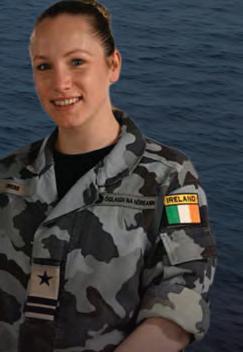













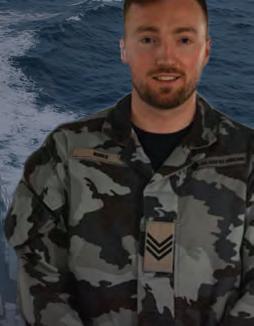






TARGETOVER 18,000 MEMBERSOF THE MARINE COMMUNITY BY ADVERTISINGYOUR JOB VACANCY IN To find out more, contact Matt Hall Matt.hall@thinkpublishing.co.uk / 02037717257
VYTAUTAS KIELAITIS, ANTONSAN VIA SHUTTERSTOCK
forindesign,butchangingfuel isfarmorecomplex.“Thefuelis linkedtothefundamentalprime movers;changefuelandyoumay havetocompletelyopenuptheship, cutitintwo,gutitandputitback togetheragain.”
Itcanbedone–theUKRoyal Navy’sType45classiscurrently goingthroughaPowerImprovement Project,whichinvolvesinstalling additionalpower-generation sourcesineachship.Thismajor conversionprojectincludes replacingthetwoexisting generatorsoneachshipwith threelargerunits.

Cannavieshedgetheirbetson fueltoavoidsuchupheavallater on?Beardsaysalternativefuels aresplitbetweenthosethatare cryogenic(hydrogen,ammonia)and othersthatcanbestoredmuchlike diesel,subjecttosomeretrofitting (methanol,forexample).
“Youcouldstartputtingthings intoplace,butyouhaven’tgot anycertainty.”
Globalfuelsupply
Fuelavailabilityisakeyissue;naval vesselsneedcertaintyofsupply wherevertheyare.AsBeardsays: “Fromafuturefuelsperspective, itisdifficultbecausecommercial operatorsdon’tknowwhattheyare doinganditisallabouttheglobal fuelsupply–weneedtoensureit.”
Meanwhile,theregulationsand standardsformaritimeingeneral arestillindevelopmentforany alternativefuel.“Technically,navies couldgotheirownwayasthey aremilitaryvessels,butbecause somuchoftheirtimeisspentin peacetimeinfloatingembassy andotherroles,itmakesahuge amountofsensetocomplyand haveaflagshipforsustainable technologies,”saysRigby.
“Therearecertainaspects–wherewecanstoreit,pipework, etc–thatcouldbedifferentto commercialvessels,butatthe momentdesignhastobecompliant withtheIMOandourvesselstryto be,”heconcludes.
INTER-COUNTRY COLLABORATION
JakeRigbyofBMTnotesthat collaborationonnavalvessel techandinnovationisgenerally mucheasierwithinacountry, ratherthanbetweencountries. “Toreallymaketheprogress, youhavetohavethesecombined projects,andfundingnormally comesfromwithinthecountry,” hesays.However,thereare collaborations–notleastLondon TechBridge,acollaboration betweentheUSNavyandRoyal Navy“tofosterconnectivity, agilityandinnovation”.
Itsmission:“Itsupports dialogue,jointinvestment andcooperativedevelopment betweenthetwonaviesas theyendeavourtoadvance frominteroperabilityto interchangeability.”
Rigbysays:“Aredifferent naviesworkingtogether?Yes, itisstartingtohappen,but itdependsonwhetherthisis formallyorinformally.For example,wealreadyhave continuouscollaborationacross NATO,whichhasanumberof workinggroups.NATO’sannual shipdesignsymposiumisall aboutcollaboratingbothfrom thedesignandoperationalside.
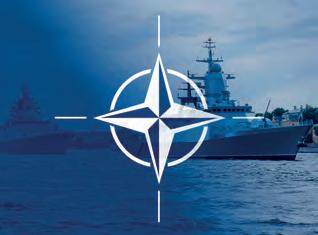
“Fromtheindustryside,most oftheindustryhaspartnerships, quitenationallygrouped; industryisstartingtolinkup.”
BMT’sThomasBeardalso highlightstheInternational NavalSafetyAssociation,which bringstogether13naviesand sevenclassificationsocieties.
23 NAVAL INNOVATION MARINE PROFESSIONAL Issue4/2022
“Thatisthebigchallenge aroundautonomy –digitalisationand connectivityneedto belinkedtoensureitis safefromcyberattack”
Naval vessels are not constantly involved in conflict – their roles vary in peacetime
>

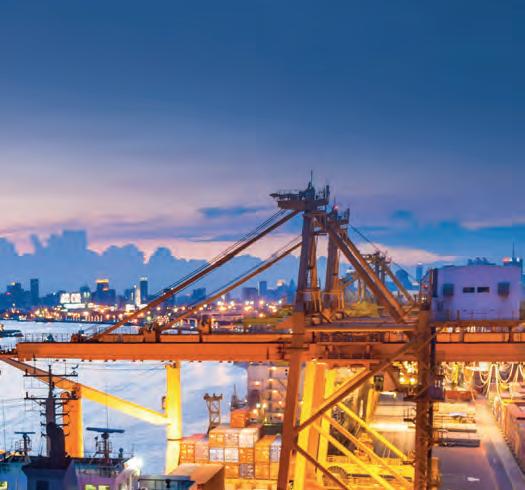
















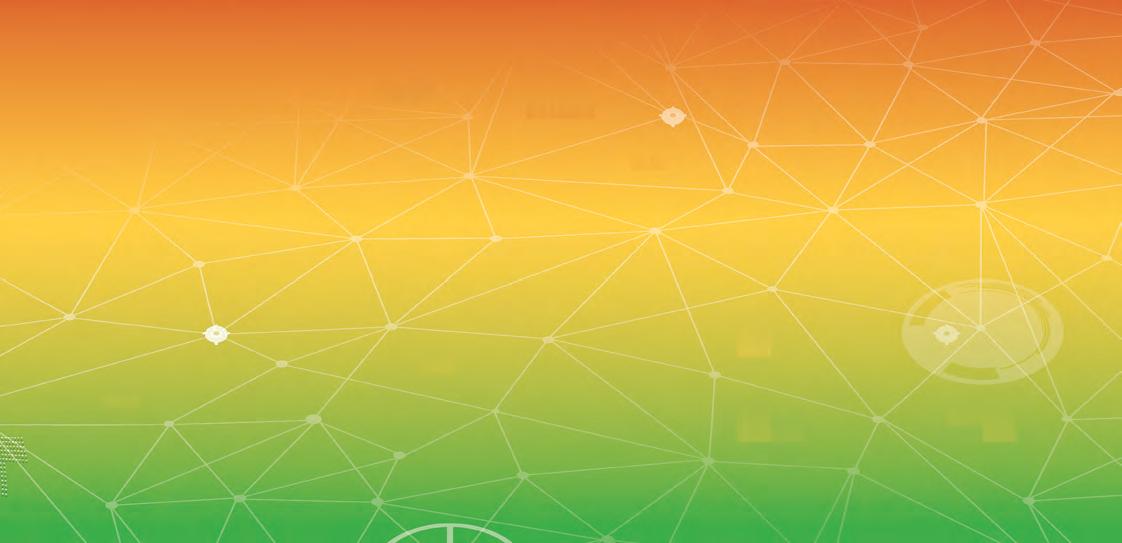

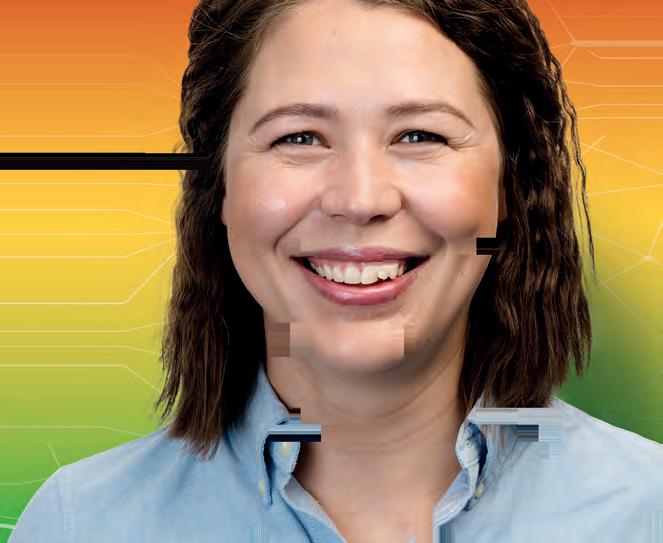
































Driving innovation in India’s Navy
Bridging
BY FELICITY LANDON
TheIndianNavycreatedtheNaval InnovationandIndigenisation Organisation(NIIO)twoyearsago, tobridgethetechnologygapthrough innovationandtheinvolvementof bothacademiaandtheindustry.
NIIObroughttogetherthenew TechnologyDevelopmentAcceleration CellandtheexistingDirectorateof Indigenisationtofacethechallenges thatdisruptivetechnologiesare creatinginnavalwarfare.
“Theaimofthisorganisationisto leveragethestrengthsofacademia andtheindustryandsynergisetheir effortstowardsfindingthestateof-the-artsolutions,”saysretired Commodore(Dr)RakeshKumar Rana.“Towardsthis,MoUsarebeing signedwithrelevantuniversities,startups,individualsandtheindustry.”
Toengageyoungmindsinpremier educationalinstitutions,theIndian NavalStudentsTechnicalEngagement Programmeprovidesafive-month onlineinternshiptoworkonnaval problemstatements,heexplains.
TheDefenceInnovation OrganisationoftheMinistryof Defence(MoD)iscollaborating withtheNIIOthroughtheflagship programmes–DefenceIndiaStartup Challenge(DISC),DISC(SPRINT) andOpenChallenges–tofind innovativesolutions.
TheIndianNavy’smaidenNaval InnovationandIndigenisation Seminar‘Swavlamban’washeldin NewDelhiinJuly.Theprogramme includedthelaunchoftheSPRINT challenges,whichspanawiderange oftechnologyfields,including artificialintelligence(AI),autonomous andunmannedsystems,andIT.
Digitisationandconnectivity
“Digitisationandconnectivityarethe mostimportant[challenges]asper myunderstanding,becausetheylay thefoundationforautonomy,”says Rana.“Forthenavalshipsandfleet tooperatewithenhancedautonomy, thefirstandforemostrequirement isthedigitisationoftheprocessand theinformationon-boardships, andthentheirconnectivitywith eachother,andthecommandand-controlplatform(ship)inthe fleet.Autonomyalsoincludesother technologiesunderthegambitof Industry4.0–AI,ML,robotics, computervision,advancedsensors, 3Dprinting,drones,etc,arealso beingprogressivelyappliedto navalvessels.”
Outofshipping’s2.98% contributiontototalgreenhousegas emissions,theamountcomingfrom navalplatformswillbeminuscule, saysRana.“Notwithstanding, effortstowardsfueltransitionisa journeythathascommenced,but willtaketimetomature,initially inthemerchantfleetand,oncethe technologiesmature,theywillsurely findtheirwayintothenavalships.”
NewAIproductslaunch Ranasaysvariousorganisations withintheIndianNavyarefocusing onalltheseissues,themostnotable beingtheWarshipDesignBureauand theWeaponsandElectronicsSystems EngineeringEstablishment,along withsupportfromotherdirectorates withinnavalheadquarters.

“Beingcognisantofthefact thatfuturewarsaregoingtobe algorithmicwars,whichwillensure aminimumnumberofnaval personnelareputinharm’sway,the MoDhasestablishedaTaskForce onArtificialIntelligence,whichhas membersfromallthestakeholders –government,armedforces, academia,R&Dorganisationsand,of course,theindustry,fromwherethe finalsystemoraproductwillflow.”
Aspartofthisinitiative,India’s defenceministerlaunched75newly developedAIproductsfordefence applicationsataneventinJuly.
25 MARINE PROFESSIONAL Issue4/2022
VIPER-ZERO VIA SHUTTERSTOCK
“Effortstowardsfuel transitionisajourney thathascommenced, butwilltaketimeto mature,initiallyin themerchantfleet”
thetechnologygapthroughinnovation NAVAL INNOVATION >
Victory for Australian naval partnership
Atlantic&PeninsulaAustralia(A&P Australia),anestablishedpartner fortheCapabilityAcquisitionand SustainmentGroup(CASG)onbehalf oftheRoyalAustralianNavy(RAN), providesmaritimesustainment servicesacrossengineeringanddesign, shiprepairandassetmanagement.

Bestknownforprovidingin-service supportfortheBayClassLanding ShipDockHMASChoules,A&P Australiaiscurrentlydeliveringthe largestship-repairprojectinSydney tobeundertakeninthepast15years.
ScottWilley,managingdirector ofA&PAustralia,says:“Thesupport wedelivertoHMASChouleshas expandedexponentiallyoverthe last10yearsaswehavebecome anestablishedpartnerforCASG.
“AsignificantportionofA&P’s growthoccurredduringCovid-19, whenA&Pgrewitsworkforceby approximately40%,continuedto developindustrypartnershipsand growitsin-countrysupplychain–supportingDefence’sobjectiveof ensuringthecontinuoussustainment oftheRoyalAustralianNavalFleet.”
Startinglifein2012withfivestaff, today,theA&Pteamhasgrownto morethan85,98%ofwhomare Australiancitizens.Theircollective experiencestemsfrom40different industrysectors,whichtogether offersallfacetsofamoderndefence sustainmentorganisation,including shiprepairandsustainment,asset managementanddesign,and engineeringformajorplatform systems,weapons,communications andspecialistmissionsystems.
“TheIMarESTmembership programmeiscoretothecontinuous professionaldevelopmentofour
workforce,providingopportunities fortraining,rangingfromstudents throughtotheorganisation’smost seniorandexperiencedengineers,” saysWilley.
Expandingthetalentpool
“Aswecontinuetofocusongrowing themaritimesustainmenttalent pool,weareproudtoofferarangeof talentpathwaysthroughinitiatives suchasourengineeringinternship programme,supportinguniversity studentsandengagingyoung professionalsearlyintheircareer,to showcasetheopportunitiesavailable withinthemaritimeindustry.”
A&PhasbuiltanAustraliansupply chainofmorethan300businesses, allofwhichuniquelyhelpandare criticaltosupportingtherequired maintenanceoutcomesforHMAS Choules.Withthis,A&Phasachieved closeto90%AustralianIndustry
Content–atremendousachievement foraEuropean-builtvessel.
A&Pisnowpreparingtobecome akeypillarinthedeliveryofthe newclasslifecyclemanagement, designsupport,dockoperations andregionalmaintenanceprovision opportunitiespresentedbyCASG’s PlanGalileoandtheFutureMaritime SustainmentModel.
InMay,A&Pannounceditsplansto collaboratewithBabcockAustralasia andNavalShipManagementonlarge shipsustainmentopportunitieson theeastcoastofAustralia.
Willeysays:“A&P’sagileapproach hasyieldedstrongresultsfor Defence,assuringtheseaworthiness ofHMASChoules,duringtherecent multimillion-dollarupgrade programme,demonstratingour capabilitytodeliverlarge,complex maintenanceprogrammes.AsDefence continuestherapidroll-outofitsnaval programmes,A&Pstandsreadyto replicatethesuccessoftheIn-service SustainmentandSupportcontract onfutureprogrammes,helpingto supportthecontinuoussustainment oftheRoyalAustralianNavalFleet.”
26 NAVAL INNOVATION MARINE PROFESSIONAL Issue4/2022
ThecontinuinggrowthofA&PAustraliahelpstosupport thesustainmentoftheRoyalAustralianNavalFleet
CPL BRANDON GREY
“TheIMarESTmembership programmeiscore tothecontinuous professionaldevelopment ofourworkforce”
An Australian Army helicopter lifts a howitzer onto HMAS Choules during an exercise
“TheattackonthePLA providesyetmoreevidencethat organisedattackerswhowish tocausemaximumdisruption arelookingincreasinglyat maritimeportsandvesselsas primarytargetsfortheirattacks,” saysDrKemediMoara-Nkwe,a researchfellowattheMaritime CyberThreatsResearchGroup, UniversityofPlymouth.
IntheUK,thePortofLondon Authority(PLA)suffereda cyberattackinMaythatknocked itswebsiteoffline–anaction carriedoutbypro-Iranian hackingactivistswhotarget public-sectororganisations forpoliticalratherthan financialreasons.
In2017,Maerskwasputout ofactionforseveralweeks byaNationStatecyberattack thatcostitanestimated$300m.

Increasingvulnerability Overrecentyears,numerous maritimecompanieshave fallenvictimtoserious,often debilitating,cyberattacks.
“Withreducedinsurance accessalongsideincreasing cyberthreatsandtightening regulations,manyorganisations arenowlosingcyberinsurance asanimportantriskmanagement tool–thosewhocanstillget insurancearestartingtopay aprohibitivelyhighcost,”warns HuntsmanSecurity’sCEO, PeterWoollacott.
AndinJulythisyear,thePort ofLosAngelesrevealeditwas workingwiththeFBIafter sufferingastaggering40million cyberattacksinjustonemonth.
HuntsmanSecuritysuggests it’satrendthathasthe potentialtothreatenthe entiredigitalfutureof theglobalmaritimesector.
AreportinTheWallStreetJournal statesthattheinsurancegiant Lloyd’sofLondonrecently instructeditsassociatesto startexcludingNationState cyberattacksfromitsinsurance policiesfromtheendofMarch nextyear–amoveseenby manyindustryobserversasa highlysignificantdevelopment. Itrevealshowleadinginsurers havebeguntobelievethat cybersecuritypoliciesare startingtobecomeunviable. Andnewresearchbythe riskmanagementspecialist
BYDENNISO’NEILL
Cyberinsurance concernsmount
27 MARINEPROFESSIONAL Issue4/2022
ALEXANDER GEIGER, SIMON VAYRO VIA SHUTTERSTOCK
Withdigitalattacksonmarineassetsontheincrease,concern isgrowingthatcybersecurityinthesectormaysoonbecome prohibitivelyexpensive–ifnotentirelyuninsurable
CYBER I <
Last year, Transnet, the firm that runs South Africa’s ports infrastructure, suffered severe disruptions following a ransomware attack. It caused container terminals around the country to stop functioning and forced port officials to record ship movements manually.
Security agencies are warning the maritime sector about heightening cyber risks due to the conflict in Ukraine, with NATO urging vessels in the Black Sea to prepare for threats of GPS jamming, Automatic Identification System spoofing, communications jamming and electronic interference. The US Cybersecurity and Infrastructure Security Agency has also warned the international shipping sector that it is likely to become a major target for sophisticated Nation State cyber adversaries.
Underwriting concerns
With geopolitical risks on the rise, the prospect of even more malicious international State-based digital attacks against assets in the marine sector are clearly increasing, according to research published by leading insurer Allianz in its Safety and Shipping Review 2022
“Cyber risk is a major concern, and we are seeing more and more incidents involving marine operations, such as ports,” explains Régis Broudin, Allianz’s global head
of marine claims. “As the industry becomes more reliant on technology and automation, the potential for a disruption from a cyberattack increases – and with the increased connectivity of ships, it is now only a matter of time before it will start to affect more and more vessels.”
The World Shipping Council has estimated that it takes an average of 279 days to resolve a cyber breach aboard a ship, with digital intrusions, often via USBs, sometimes going undetected for years, allowing cybercriminals plenty of time to steal confidential data and information. The criminals will have many different reasons for trying to access the systems of a ship, marine asset or maritime company – ranging from identity theft to company defamation.
So now, with so many aspects for potential problems, insurers such as Lloyd’s have finally begun to feel that underwriting the maritime sector may not be as attractive as it once was.
“Given the increase in the number and severity of cyberattacks leading to higher claims, what was once a fairly profitable line of business

for insurers has quickly turned into a category with potentially unsustainable financial returns,” explains Chris Martin, corporate partner at the Asia-Pacific advisory and investment firm KordaMentha.
Multimillion-dollar payouts
Unfortunately, the marine sector may not be doing all that it should be doing to help itself, according to research by the global law firm HFW and maritime cybersecurity company CyberOwl. The research has discovered that, where cyberattacks in the maritime industry do eventually lead to a ransom payment, shipowners are now paying out an average of around $3m each time to the criminal perpetrators.
Brian Grant, a director at Thales Cloud Security, warns that such ransom payouts will only exacerbate the cyber risks arising among datadependent companies in the sector.
“Paying a ransom just fosters further criminal behaviour,” he argues. “And while it’s encouraging that many businesses have devised cyber-incident response plans, there is still a worrying lack of effective data security, which leave gaping holes for criminals to exploit.”
The HFW/CyberOwl report also confirms that there are serious gaps in cyber-risk management among shipping organisations and the wider supply chain, with shipowners still significantly underinvesting in their cybersecurity management. More than half, it has found, are still spending less than $100,000 per year to protect their digital networks.
“Technology in the shipping industry is changing at an astonishing pace,” says Tom Walters, a partner at HFW. “The use of IT already underpins so much within global supply chain operations.
So, as we look to the future and the adoption of alternative propulsion
CYBER
ALEXANDER GEIGER, DENISGO
VIA SHUTTERSTOCK
28 MARINE PROFESSIONAL Issue 4/2022
“Given the increase in the… severity of cyberattacks leading to higher claims, what was once a fairly profitable line of business for insurers has quickly turned into a category with potentially unsustainable financial returns”
Is the shipping industry doing enough to protect itself from cyberthreats?
to do a lot more
Identifying attacks
protect
explains. “And being clear on whether a particular incident is Nation State sponsored or just a very sophisticated criminal attack may not be possible. This would then result in significant legal issues around the validity or not of the insurance claim.”
Dr Kimberly Tam, a cybersecurity lecturer at the University of Plymouth, believes that the move by Lloyd’s will lead to significant and unintended problems later.
“The attribution of a cyberattack is very difficult to discern,” she
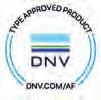






It’s a point of view shared by Ian Bramson, global head of cybersecurity at ABS Group and chair of the IMarEST’s Maritime Cyber Risk Management Special Interest Group.

“Cyberattacks can be almost impossible to definitively attribute to a specific source or group,” he says.

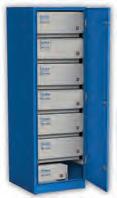
“Many threat actors – from Nation States to terrorist organisations – use cyberattacks as part of their arsenal because it offers a concept called ‘strategic ambiguity’, making it a very useful tool when they want to send a message or blame another party under false flag operations. Additionally, many cyberattacks can be masked as operational breakdowns, making them even harder to detect, which puts immense pressure on insurance companies validating claims and underwriting risk.”
For more information or to join the Maritime Cyber Risk Management Special Interest Group, contact chair Ian Bramson at ibramson@ eagle.org. From January 2023, you can view on-demand the Cybersecurity & Autonomy session from the IMarEST’s Annual Conference on IMarEST TV.

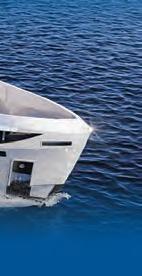



29 MARINE PROFESSIONAL Issue 4/2022 www.becker-marine-systems.comManoeuvring Systems Energy-Saving Devices Battery Systems LFP BATTERY COBRA is an advanced maritime battery system for all kind of ships such as ferries, tugs, cruise ships, yachts, OSV and harbour/service vessels which incorporates leading-edge features: •DNV Type Approval •ESTRIN compliant (IEC 62619 & 62620) •Superior energy density •Compact and light-weight battery system •Integrated Battery-Management-System •Air or water cooling •Scalable and modular rack system up to several MWh •Inherently safe LFP battery chemistry for highest safety •Environmentally friendly cobalt-free battery 121 ft Yacht with 478 kWh COBRA Battery System e nvironmentallyfriend l y becker products systems and autonomous ships, the importance of cybersecurity will only become more important. “It is therefore abundantly clear from our research that the shipping industry needs
to
itself from cyberthreats.”
Many organisations are losing cyber insurance – some who can still get it can pay a ‘prohibitively high’ cost becker marine svstems •
You say ‘tomato’, I say ‘tomayto’
BY MARTIN SHAW
In recent discussions about the IMarEST’s strategy, there has been mention of relevance – ensuring that what the IMarEST does is relevant to its membership. This is in addition to all the excellent conversations going on between the executive, Branches and Special Interest Groups (SIGs).
Another interesting point raised in these discussions has been that the word ‘technical’ has little relevance in the world of science. It got me thinking that we might have a language problem; maybe we have created our own language within the IMarEST that is not relevant to each of the professions (engineering, science and technology), nor indeed the sectors and disciplines within these professions. We need to recognise and manage that diversity. If we want to attract new members from different sectors, we don’t want them to have to develop a new language; we need to speak theirs. So, we need to be coherent – my new favourite word.
Googling the words ‘ships’ and ‘automation’ will tell you that language used to promote autonomy may be confused with ‘automation’. I appreciate that we have to define different levels of Maritime Autonomous Surface Ships’ capability, but is that language
‘backwards compatible’ with the language used by the hundreds of thousands of people involved in running the tens of thousands of ships in service today? Or to potential new members?
We need to be coherent and start with a basic fact: the ship of today may already be highly automated in the traditional meaning of the word. One definition of automated is: ‘The technique of making an apparatus, a process or a system operate automatically.’
Advantages of automation
I recall in my earlier days at sea, sailing on some of the earlier examples of automated ships, one ship with an alarm system based on a refinery model having a massive drawing (on chart paper) showing the position of each alarm box on the panel. Strange, I thought. A few days later, the ship was hit by a big wave and on return to the control panel, most of the boxes were lying on the deck. Then, I was grateful for that drawing. I also recall an early bridge control system, which worked by fitting a pneumatic cylinder to the engine control lever. It was wise to stand clear when manoeuvring.
Developments in the late 1960s and 1970s resulted in more systems working automatically to the extent that unattended machinery spaces (UMS) notation was introduced, allowing engineers

to dispense with watchkeeping at sea. It should be clear that then, as now, that generally meant the engine room UMS was overnight and that required preparation. The automation of engine room systems obviates the need to continually adjust engine systems. Initially, that gave you a much bigger engine room workforce for maintenance. It also resulted in fewer engineers and a reduction in cost.
Automating boiler controls removed the need for firemen,
30
We need to be coherent and start with a basic fact: the ship of today may already be highly automated in the traditional meaning of the word
KARDASOV FILMS
We need to all speak the same ‘language’ if we want to stay relevant
A marine engineer officer in an engine control room
MARINE PROFESSIONAL Issue 4/2022
while on the bridge, automation increased with electronic chart systems, collision avoidance radar and even integrated bridges and dynamic positioning.
On tankers, automating the operation and monitoring of cargo reduced the number of deck crew required. If you add other changes, such as general-purpose crews and removing the catering and radio, then crew size has reduced significantly in the last half-century. A 40,000-tonne ship built in the
1950s could have 50 crew. A similar size ship built in 1990 could have had 20. In many cases – particularly with higher-wage economies – the number could be much less. The latest container ships may run with 13.
So, automation has already resulted in significantly reduced crews. Ships have a safe manning certificate, which stipulates the minimum crewing required to operate a ship safely. Generally, most ships have crewing that allows
safe operation for the busiest operations, such as mooring the ship for a limited period of time in the event of an automation failure. Beyond that, though, the crewing scale is a function of maintenance strategy. A shipowner can maintain a ship using the crew on-board with riding squads and with maintenance by contractors in port and during dry dock. Most owners predominantly use the ship’s staff, aided by specialist contractors, with major work done in dry dock. Reducing the engineering complement further may result in cost increases in port repairs and dry docks.
Clear communication Interestingly, the easy wins in crew reduction may have already taken place and we may be into the law of diminishing returns where crew cost savings may be small but at a large cost.
If you ask a marine engineer in the shipowning business what they want from automation, the answer will be better, not more, automation. And that is automation that is reliable, predictable and can cope with the heat, vibration and salt atmosphere that goes with a ship; automation that you can troubleshoot, repair or replace. If not, you need redundancy to allow the ship to continue. Some standardisation of the user interface would also be good and operation, which is instinctive.

My main point is that to help those who are dealing with today’s ships with today’s problems, you must use language carefully. You need to be ‘coherent’. You may even need some adjectives. So, if you are talking about there being a need for more ‘digital’ automation, say so. If you are talking about ‘intelligent’ automation, then again, say so.
Martin Shaw MNM FIMarEST is president-elect of the IMarEST and managing director of Marine Operations and Assurance Management Solutions Ltd.
31
MARINE PROFESSIONAL Issue 4/2022 TECHNOLOGY V •
Britannia’s predecessors: the steam-powered royal yachts
With a new royal yacht in the offing, Marine Professional looks back at past designs
BY JOHN BARNES
According to the recently revised National Shipbuilding Strategy report, the UK government is to build a new National Flagship at a reported cost of £250m, which could enter service between 2025 and 2026. It will be used to showcase the UK and promote Britain abroad –an unofficial role undertaken by Britannia, the last royal yacht until decommissioned in 1997.
The use of a yacht by royalty for pleasure rather than military purposes goes back many centuries.
Prior to the middle of the 19th century, these were sailing yachts, but in due course steam vessels were acquired.
It was during the early period of Queen Victoria’s reign that the first steam-powered royal yacht was commissioned. Prior to this,
the queen had to use sailing vessels. However, following a cruise to Leith in 1842 aboard the sail yacht Royal George, Queen Victoria returned to the south on a chartered paddle steamer. The experience of independence from the weather seems to have led to the queen requesting that the Admiralty should procure a steam royal yacht for her future use. The result was the keel laying, in November of that year, of the first Victoria and Albert
Built at the Pembroke Dock shipyard and launched the following April, the new vessel was a paddle steamer with a length of 60.6m and a beam of 17.8m over the paddle boxes. Tonnage was 1,034 and propulsion by a 320kW steam engine, giving a speed of 15kn. In 1853, Victoria and Albert was lengthened to 78.8m,
increasing tonnage to 1,382, and fitted with a new steam plant rated at 450kW. Two years later, with the introduction of a second Victoria and Albert, it was renamed Osborne and continued to serve until scrapped in 1868.

A year after Victoria and Albert was completed, it was joined by the 317-ton tender Fairy, which frequently accompanied its larger sibling, but was also able to cruise in shallow waters such as the Caledonian Canal in 1847. Built in 1844 by Ditchburn and Mare of Blackwall, London, Fairy was commissioned in 1845 and was 43.8m long with a beam of 6.4m. The 270kW machinery drove the single screw vessel at 13kn. Fairy

32 MARINE PROFESSIONAL Issue 4/2022
HISTORY
The second steam yacht to be named VictoriaandAlbertwas completed in 1855 at Pembroke Dock and served until 1900
The third VictoriaandAlbertsuffered initial stability problems, but once these were solved, it was operational until 1937
served until 1863 and was broken up in 1868.
In 1848, another tender was added to the royal fleet, the Elfin, built at Chatham Dockyard. A paddler, 31.3m long with a beam of 7.5m, it was used for many years as a dispatch boat by the royal court and was known locally as the ‘milk boat’, making daily runs between the Isle of Wight and Portsmouth or Southampton with papers and dispatches until being placed on the sale list in 1901.
A second V and A
A more modern vessel, the second Victoria and Albert, was built by Pembroke Dock and was originally to be called Windsor Castle Commissioned in 1855, it has been described as a far more substantial and imposing vessel than anything that had gone before. The design was by Sir Oliver Lang, but Albert, the Prince Consort, was responsible for laying out the royal apartments, which included a music room and
a school room for their children. At 110m long with a beam of 12m, the ship displaced 2,390 tons and the 1,800kW steam machinery drove paddles that gave it a speed of 15kn. Victoria and Albert would serve until 1900 before being broken up in 1904.
Another tender, the Alberta, was added to the royal fleet in 1863 to replace the Fairy. Once again built by Pembroke Dock, Alberta was a 370-ton wooden paddle steamer,
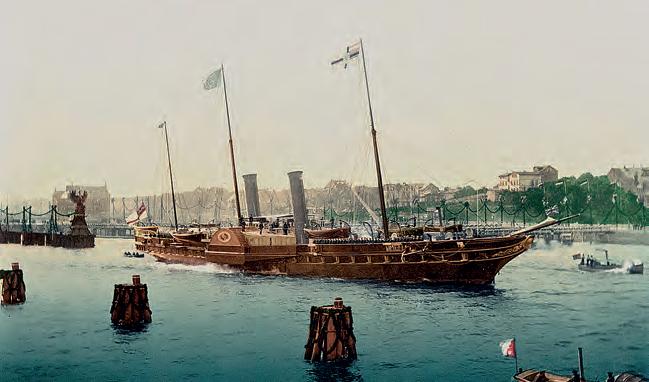
 DIGITAL HISTORY, THE IMPERIAL COURT, LIBRARY OF CONGRESS
DIGITAL HISTORY, THE IMPERIAL COURT, LIBRARY OF CONGRESS
33 MARINE PROFESSIONAL Issue 4/2022
Albert, the Prince Consort, was responsible for laying out the royal apartments, which included a music room and a school room
Offering more flexible operation was the smaller Osborneof 1870
>



'COX cxo300.coxmarine.com Lower emissions. The CXO300 compared to a gas-powered outboard engine* 30°/o Lower emissions* 30o/o Lessfuel* Cox Marine aims to significantly reduce marine emissions and the total cost of ownership for our customers through the application of innovative technologies in high-performance propulsion and systems. To learn more and to download a brochure, visit cxo300.coxmarine.com Oo/o Compromise
49mlongwithabeamof7mand adraftof2.4m.Followingthe acquisitionofOsborneHouseon theIsleofWightasasummerhome fortheroyals, Alberta oftenmade voyagesacrosstheSolentandalso tookthequeentoengagements alongthesouthcoastofEngland.
Followingherdeathon 22January1901, Alberta carried QueenVictoria’sbodyon1February fromCowestoGosportforonward transporttoLondonandthestate funeral.Thetendercontinuedto serveformanymoreyearsafter andwasonlybrokenupin1913.
Joiningtheroyalfleetin1870 wasthenewpaddletender Osborne, anotherfromPembrokeDock.
Designedbytheleadingnaval architectEdwardReed,andat1,850 tons,itwas76mlongwithabeamof 11m.Theshiptookthenameofthe formerfirst VictoriaandAlbert and wouldoperateuntil1908.
Replacingitthatyearwasthe 2,113-gross-ton Alexandra,built byA&JInglisofGlasgow,which alsooperatedasahospitalship duringWorldWar1,andremained inserviceuntil1925whensoldto Norwegianinterests.Measuring 90mlengthby40mbeam,itwas fittedwitha2,600kWfour-cylinder compoundsteamengineproducing aspeedof17kn.
VandAthethird
Onceagain,PembrokeDockwas taskedwithbuildingthethird VictoriaandAlbert,whichwould servebetween1901and1937.The designwasbySirWilliamWhite, thechiefconstructoroftheRoyal Navy,andwaslaunchedon9May 1899.However,wheneightmonths laterithadcompletedfittingout inadrydock,therewasaproblem. Whenthedockwasbeingflooded, the VictoriaandAlbert suddenly listedoveruntilitshullrestedon thedockside.
Oninvestigation,itwasfound thatanextra771tonsofmaterial hadbeenincorporatedover thedesignfigure.Torectifythe problem,260tonswasremovedby fittinglightermasts,funnelsand soon,and250tonsofleadballast wasaddedtothedoublebottom. Asdesigned,themetacentric heightwouldbe0.6mfullyladen and0.25mwhenlight;atthetime offloatout,itwascalculatedthe figureswere0.07mfullyladenand negativewhenlight.Thealterations producedaladenfigureof0.7mand
Britanniawasdesignedto beconvertedintoahospital shipintimeofwar,butwas neverusedinthisrole,even duringtheFalklandsWar
0.5mwhenlight,andthenewyacht wasthenabletooperatesafelyfor thenext36years.Decommissioned in1939,itservedasadepotship duringWorldWarIIandwasbroken upin1954.
Thelastroyalyacht
Themostrecentroyalyachtwas the Britannia,nowamuseumship mooredinLeith,Scotland.Thistime itwastheJohnBrownshipyardon theRiverClydethatwascontracted tobuildthenewvessel,laiddown in1952,launchedbyQueen ElizabethIIon16April1953,and commissionedon11January1954.

Thelastroyalyachtwas126m longwithabeamof17mandhad agrossregisterof5,769tons.Power wasprovidedbytwoPametrada steamturbinesforatotalof 8,900kW,givingaspeedof21.5kn andenoughfuelwascarriedfor arangeof2,400nm.
Britannia wasdesignedtobe convertedintoahospitalshipin timeofwar,butwasneverusedin thisrole,evenduringtheFalklands Warof1982,whenitwasfeltthat thefuelitusedwouldbedifficult toreplenishduringtheconflict. However,in1986, Britannia rescued Britishandotherforeignresidents caughtinthecrossfireduringthe civilwarinSouthYemen.
35 HISTORY MARINE PROFESSIONAL Issue4/2022
DOWNING STREET
National flagship concept
Marine environmental monitoring for a sustainable future
Advancements in observation techniques are promising, but more collaboration is needed
BY SAM ANDREWS
“Fundamentally, we depend on the ocean.” Dr Ralph Rayner, cochair of the IMarEST’s Operational Oceanography Special Interest Group, professorial research fellow at the London School of Economics and Political Science, and chairman of Sonardyne International, says the dependencies are many: oxygen, food, transportation, culture and human wellbeing, to name a few.
“The big issue for me is the balancing act between using the ocean and ocean resources, and protecting ocean health and ecosystem services,” Dr Rayner says. “It’s the role of ocean monitoring to inform that balance.”
Dr Rayner, whose career has spanned more than 40 years, has seen many changes in marine environmental monitoring, but three developments stand out: “In-situ instrumentation, the capacity to build things that can make measurements in the ocean in the long term; high-quality satellite observations and
continuous operational satellite observations; and the operational modelling and analytical systems that stitch all of that together.”
Indeed, these developments are being harnessed for a host of global and local monitoring programmes.
In-situ monitoring
The Great Barrier Reef is arguably one of the most well-monitored marine ecosystems in the world. Some monitoring programmes are biological, focusing on seagrasses, coastal birds or the hard corals that make up the mid- to outer sections of the reef, for instance. Others, like the Inshore Water Quality Monitoring Program coordinated by the Great Barrier Reef Marine Park Authority, focus on the ocean.

“When people think of the reef, they think about the blue water or the corals. The inshore reefs where the water isn’t as clear also have cultural, scientific and ecological importance,” says Dr Martina Prazeres, project manager of the Great Barrier Reef Marine Park Authority Marine Monitoring
Program. These inshore areas are threatened by pesticides, nutrients, waste and sediments that make their way into the system through river flow, flooding and water run-off from the land. These inputs reduce water quality, impacting the health and resilience of inshore ecosystems.
The programme harnesses multiple in-situ instruments, such as conductivity temperature depth profilers, which give vertical profiles of salinity and temperature, and in-situ data loggers that collect turbidity, chlorophyll a and pesticide concentration readings.
“We have around 80 sites in total [for] routine and event monitoring,”
36 MARINE PROFESSIONAL Issue 4/2022
The vast Great Barrier Reef –one of the most well-monitored marine ecosystems in the world
~· --::--=---• •• ,,.,__.,•- '' I •
says Dr Prazeres. In the wet season, satellite remote-sensing products complement the in-situ data collection with information on river plume extent, water gradients and measurements of various properties such as particulate nitrogen loads.
The water-quality data feeds directly into the Paddock to Reef Integrated Monitoring, Modelling and Reporting Program, which aims to improve conditions on the reef by initiating effective management

in the ‘paddock’ (agricultural lands) and water-catchment areas.
The root source of some changes in water quality, such as pesticide loads, are relatively easy to identify. Others are more difficult. “Sediment is natural in the system, so it can make correlations [between weather events or management practices and sediment loads] more difficult,” says Dr Prazeres. Long-term data from across the reef is proving crucial. “We have 17 years of data sets. We can see trends where water quality is declining or improving, and then potentially track that back to changes in practice in the paddock,” she explains.
Pinpointing the polluters
Out in the open ocean, another human-based threat is being tackled with monitoring. For safety, bilge water – a mix of fresh and seawater, oil and chemicals that make their way into bilges, the lowest compartment of a ship – must be discharged periodically. Under the International Convention for the Prevention of Pollution from Ships, the bilge water must be treated before it is released into the ocean.
“[Untreated] bilge dumping has been illegal for decades, but there’s generally no way to detect or enforce it,” says Jason Schatz, chief technology officer with the non-profit environmental watchdog SkyTruth.
Enter Cerulean, a platform based on artificial intelligence (AI) that will detect oil slicks from vessels, offshore oil platforms and other sources. Cerulean harnesses synthetic aperture radar imagery (images of the Earth’s surface created with radars) from the European Space Agency’s Sentinel1A and Sentinel-1B satellites to find bilge dumps in the ocean.
“In radar imagery, the ocean looks like a noisy, dark surface, but oil tends to make the ocean surface look a lot smoother and darker,” says Schatz. While vessels can be spotted in the imagery, Cerulean uses Automatic Identification System (AIS) data, which includes vessel location, course, speed and vessel identity information to connect a vessel with a dumping event. “[The AI] compares the tracks of vessels [from the AIS] with the tracks of oil slicks to identify who’s probably responsible for different pollution events,” he explains.
When Cerulean is out of the development phase, the hope is that the data will help hold polluters accountable, reduce the frequency of illegal dumping, help advocate for better regulation and enforcement where needed, and support marine pollution research.
37 MARINE MONITORING MARINE PROFESSIONAL Issue 4/2022
The root source of some changes in water quality, such as pesticide loads, are relatively easy to identify
I SHAFIQ VIA SHUTTERSTOCK >
Monitoringgapsstillexist
WhileSkyTruthandtheGreat BarrierReefMarineParkAuthority areusingmarineenvironmental monitoringtotargetspecifictypes ofissues,manyprogrammesare moregeneral.Whenassessing monitoringasaglobalendeavour, itisapparentthattherearegaps, oneofthemostnoticeablebeing thedeepsea.

“Ifyougofromtheatmosphere tothedeepsea,theobservations godownexponentiallyuntilthey arevanishinglylow,”saysDrAnya Waite,abiologicaloceanographerat DalhousieUniversityandco-chairof theGlobalOceanObservingSystem. DrWaitenotesthatsuchknowledge gapshamperourunderstandingof theoceanandclimatechange,and reducesourabilitytomanageour activitiesmoresustainably.
Thedeepseaisoneofthemost challengingplacesonEarthto monitor,butevenhere,thereis progress.DeepArgo,forexample,is aflotillaofroboticdriftersdesigned towithstandthecrushingpressures ofthedeepseatocollectdatasuch astemperatureandcurrentvelocity fromwatersasdeepas6km.These deep-seadriftersjoin3,500otherArgo floatscurrentlymonitoringconditions intheupper2kmoftheocean.
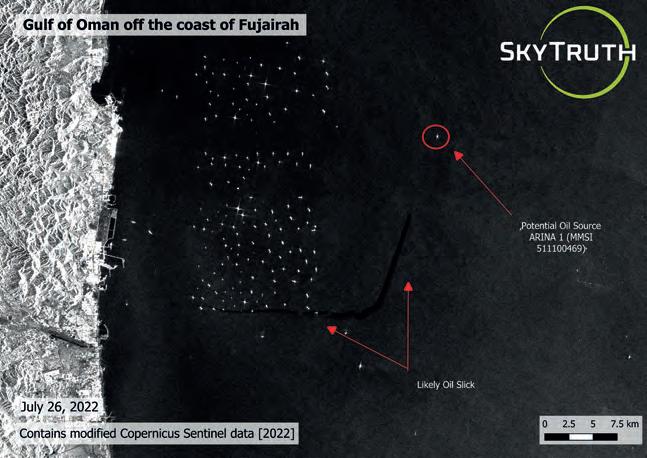
“Insomeways,we’vesolved thetechnicalproblemofmaking
theobservations,”saysDrRayner. “Therearealwaysgoingtobe improvementsinourcapacityto measurethingsthatwecouldn’t observeormeasurebefore,and gapsweneedtofill,butthe biggestobstacletosustainedocean observationislackofcoordination.”
BothDrRaynerandDrWaite pointtotheWorldMeteorological Organization(WMO)–atreatybasedorganisationthatlegallybinds nationstogethertodevelopand cooperateonatmosphericscience–asagoalfortheoceanobservation community.“It’snotjustabout stickingmoreobservationsinthe oceannecessarily,thoughthat mightbeanoutcome.Weneedto havefundedpositionsforpeople todrivegovernanceandgetaglobal systemrunning,”saysDrWaite.
Thebenefitsofalegally mandatedorganisation,DrWaite andDrRaynerargue,aremultiple.
Amongthemostimportantis securinglong-termfunding.
“Around73%ofocean observationsareinsecure,”says DrWaite.“Mostarefoughtforon anannualbasisbyoceanobservers needingfundingtocontinueto observeacertainsystem.That iscompletelyunsustainable.”In addition,thereistheproblemof ensuringsufficientinfrastructure exists.“InCanada,ourocean observationsaresuperinsecure,” shesays,highlightingoneexample ofabuoyoffHalifax,NovaScotia, failingwithnegativeconsequences forweatherpredictions.“We’re dependentonasinglebuoyfor criticaldata.There’snoredundancy, sowe’reinsecure,”sheexplains.
Partofthechallengeincreating anorganisationakintotheWMO liesin“turningeffectivedata streamsintoinformationpeople careabout,”saysDrWaite.
DrRaynerisworkingwiththe NationalOceanicandAtmospheric AdministrationtocreatetheBenefits ofOceanObservationsCatalogue, whichaimstodojustthat.“Ifwecan getabetterunderstandingofallof theapplicationareasandthebenefits, thenyoustartmakingastronger caseforsupportingtheoperational capacitytomaketheobservations inthefirstplace,”heexplains.
FIND OUT MORE
Formoreonmarinemonitoring ortojointheOperational OceanologySpecialInterest Group,contactDrRayner atralph@ralphrayner.com
38 MARINE MONITORING MARINE PROFESSIONAL Issue4/2022
SKYTRUTH
The Great Barrier Reef Marine Park Authority uses marine environmental monitoring to target specific types of issues
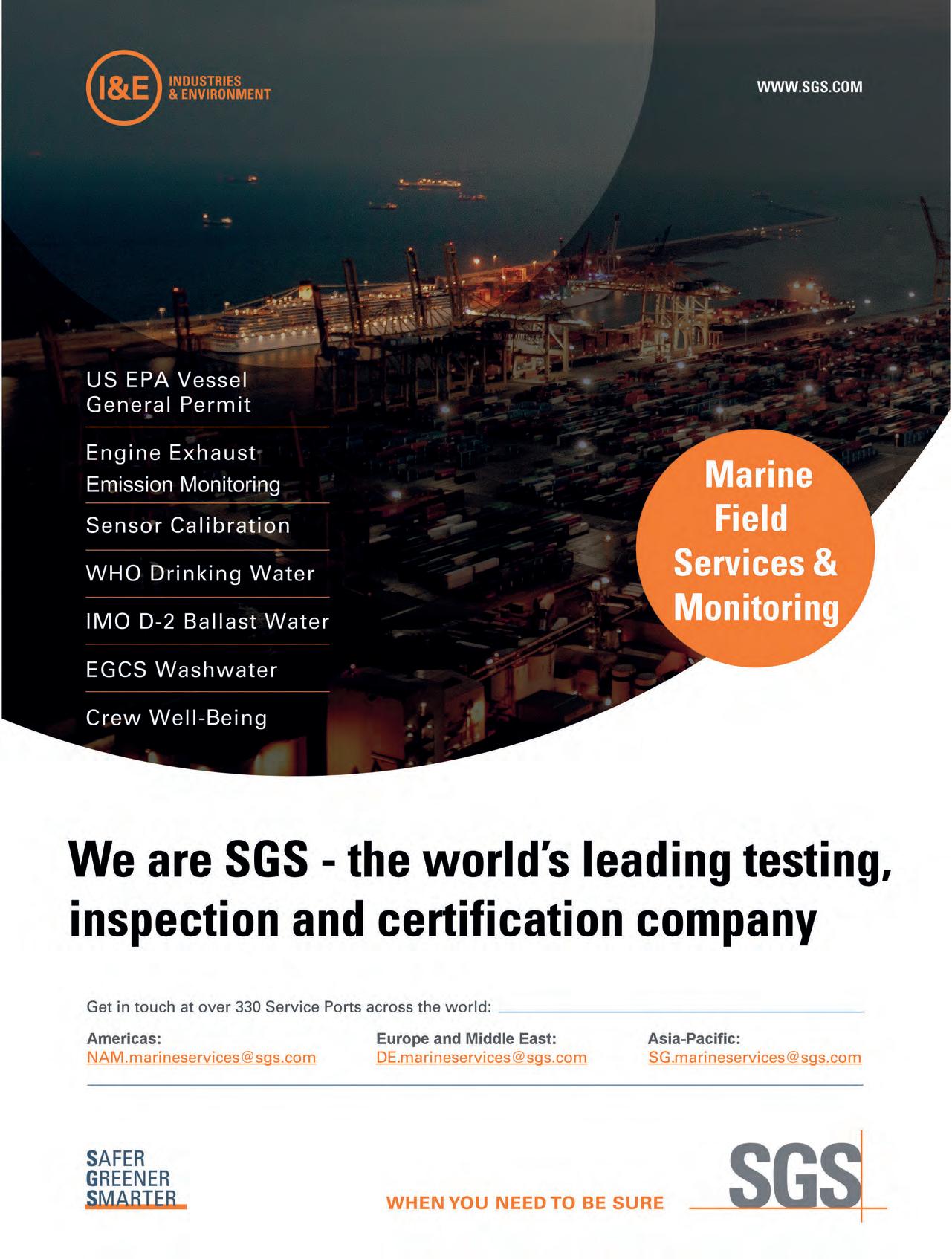
We are SGS-the world'sleadingtesting, inspectionand certificationcompany Get in touch at over 330 Service Ports across the world: ____________ _ Americas: NAM.marineservices@sgs.com SAFER GREENER Europe and Middle East: Asia-Pacific: DE.marineservices@sgs.com SG.marineservices@sgs.com WHEN YOU NEED TO BE SURE
Tackle harassment head-on
Why urgent action is needed to change the culture of seafaring
BY REZA ZIARATI
Historically, there has been a lack of support for seafarers to address their needs to manage stress at sea and virtually no system in place when they face bullying or harassment at sea. That said, the International Labour Organization (ILO) has had some positive impact on the
IMO when it comes to considering seafarers’ wellbeing.
In their latest attempt, the two bodies established a tripartite working group (JTWG) to identify and address seafarers’ issues and the human element without clearly specifying key mental health issues or bullying and harassment at sea. They have mandated the group to establish guidelines for Port State
Control and flag States as to how to deal with seafarer abandonment cases and fair treatment of seafarers detained on suspicion, and develop recommendations and draft provisions in connection to these.
At Maritime Safety Committee 105, the ILO/IMO JTWG took the decision to consider sexual assault and harassment in the maritime sector, with a view to providing

40 MARINE PROFESSIONAL Issue 4/2022
M AFIQSYAHMI VIA SHUTTERSTOCK
recommendations for future steps to address them and with the intention of changing the maritime culture regarding this. This is in addition to developing guidelines for the medical examination of fishing vessel personnel in the context of the intended revision of the STCW Convention to complement cooperation during the Covid-19 pandemic through
Stress and tiredness cause misery and accidents at sea and… the extent of bullying is greater than perceived by those working in the shipping industry
the Seafarer Crisis Action Team. A review of current developments at the IMO shows there is a great deal more to do when considering the challenges seafarers face at sea, which has been made worse by the Covid-19 pandemic.

In several papers and reports, I have highlighted that stress and tiredness cause misery and accidents at sea and that the extent of bullying is greater than perceived by those working in the shipping industry. To improve the wellbeing of ships’ crews – and hence also safety at sea – a project, PROmoting MEnTal HEAlth at Sea (PROMETHEAS), has been initiated by the Centre for Factories of the Future (C4FF) and its partners.
Seafarers who are bullied, harassed and/or suffer from fatigue or stresses are often deprived the opportunities of job satisfaction or career progress. I have studied the definition of mental health and concluded that every seafarer must be given the opportunity to work productively and fruitfully without any undue stress or fear of being belittled.
Social isolation
A series of videos produced by C4FF as part of the PROMETHEAS project proved that seafarers often work for very long hours, far from their relatives, while isolated, in a multicultural, highly hierarchical micro-society. Seafarers suffer from social isolation and are away from their family in some cases for several months, often having limited access to the internet to communicate with people ashore. Combined with the multinational nature of crews, this leads to a sense of loneliness.
Research has shown that seafarers represent one of the
most ‘at-risk’ employment groups for committing suicide, with perhaps the most obvious cause of drowning. Szymanska et al (2006, in Iverson, 2012) studied suicide trends among Polish seamen from 1969 to 1999. The researchers found that out of “324 total deaths there were 33 suicides – 10.2% of seafarer deaths, which was significantly higher than the incidence of suicides among the male Polish population over 20 years of age”. Mental stress and bullying were noted to be two of the reasons for seafarers taking their own life.
The Australian National Centre Against Bullying defines bullying as “an ongoing and deliberate misuse of power in relationships through repeated verbal, physical and/ or social behaviour that intends to cause physical, social and/or psychological harm”.
It is widely known in the shipping industry that the captain’s word is final. Kravets (2018) states: “On land, a manager refusing his employer’s instructions could be fired. But on-board, the captain’s word is law – even having more power than the ship’s owner.”
Therefore, this offers potential of opportunity for bullying. There is a quote that reads: “One believes himself the master of others…” which refers to the captain of the ship. The same quotation concludes: “…who nevertheless is more a slave”. This quote arguably sheds a distinctive light onto the division of power in the shipping industry.
Barlow and Iverson (2005, page 81, in Nielsen et al, 2013) suggests that “job satisfaction and intent to leave among employees is especially influenced by occupational stressors related to: safety, organisational leadership, characteristics of the job and the organisation”, while Feijó et al (2019) found that “authoritarian and laissez-faire leadership styles were positively associated with bullying”.
Further, the rise of multinational crews creates a language barrier, making it difficult to form a collective
41 MARINE PROFESSIONAL Issue 4/2022
SEAFARERS
Seafarers should have the opportunity to work without undue stress or fear of being bullied
>
groupandbecomeaccustomedto eachother’svaluesandnorms.This hasshowntoleadtoculturalisolation andalsoaffectsthehappinessand mentalwelfareofthecrew.
Supportforseafarers

Thebestmethodofovercoming bullyingintheworkplaceisthrough havingaconstructiveandresilient managementsystem.However, researchhasshown(Ziarati,2022) thatanindependentsystemis neededtogivea‘lastportofcall’for victimsofbullyingandharassment. Onesolutionwouldbetoaccesshelp throughthecentralhelplinesuchas SeafarerHelp,whichisagreatsource ofsupportforseafarers.Itoffers afree,confidential,multilingual helplineforseafarersandtheir familiesavailable24hoursaday, 365daysperyear.
TheInternationalChamber ofShippingrecentlyproduceda reporttitled Guidanceoneliminating shipboardharassmentandbullying. Thedocumentprovidesadvice forseafarersandtheirfamilies onthedefinitionsofharassment andbullying,andwhattodoifa seafarerfeelstheyareexperiencing eitherofthoseissues.
Meanwhile,thefollowingisa shortenedversionofBullard’s(2019) adviceforovercomingbullying, whichcouldserveasasourceof aspirationfortheIMO:
l Setoutclearpoliciesand proceduresfordealingwith harassmentandbullying andcommunicatethese toeveryoneon-board;
l Organiseawareness programmes, trainingsessions, campaigns,videos, conferencesand othermediaonhow tonoticebullying andorharassment andreport acomplaint;
l Ensureprivacy andconfidentiality toencourage disclosure;
l Establishclearjobroles, expectationsandresponsibilities byapplyingfairandtransparent processesforallocatingtasks, jobroles,etc;
l Educateeveryoneforearlywarningsigns,suchaswhen aseafarerlookssad,lonely, scared,isolated,notmotivated, lowperformance,complainsof physicalsymptoms,avoidssocial interactions,etc;
l Encourageself-awareness,social awarenessandconflictresolution andorganiseteam-building sessions,inspirationalleadership trainingsandculturaldiversity workinggroupsbyfocusingon activitieswhichpromotesocial interactionson-board.
ThePROMETHEAS interviewsclearly demonstrated thatnomatter howsophisticated theprocessand proceduresarefor reportingbullying, mostseafarersfind itdauntingtoreport casesofbullying orharassment, especiallyifthe
bullyingiscarriedoutbyamore seniormemberofcrew.
Thus,theIMOhasalongway togotoimproveseafarers’mental wellbeing.Reviewingsexual harassmentaloneisnotenough. Whatmyresearchhasshownis thatthereisadirectrelationship betweengoodpractices,leadership, safetyandmentalwellbeing.
PROMETHEASincludestwo studies,oneonmentalhealth, andtheotheronbullyingand harassment,atsea.Examiningthe factorsthatdirectlyimpactmental healthfromphysical,psychological andbehaviouralpointsofviewhas identifiedawholerangeofcauses andsymptomsforconsideration. Therearebothorganisationaland non-organisationalfactorsandthe projectofferssolutionsforthem. Theemphasisisplacedonrelevant andpracticalsolutions,butalso onpreventionandthesupport seafarersneedtoriseuptothe challengesoffacinguptobullying andharassment,andimproving theirmentalwellbeing.
ProfessorDrRezaZiaratiBSc(Eng) PhD(Eng)CertEdCMechECElecE CMarEngCEngFIMechEFIET
FIMarESTischairoftheCentre forFactoriesoftheFuture.Find outmoreaboutthePROMETHEAS projectatprometheasproject.eu. Also,watchthefirstGlobal ConferenceforSeafarerMental HealthandWellbeingonIMarESTTV.

42 MARINE PROFESSIONAL Issue4/2022
Mostseafarersfindit dauntingtoreportcases ofbullyingorharassment, especiallyifthebullying iscarriedoutbyamore seniormemberofcrew
NORMAND
FERNANDEZ VIA SHUTTERSTOCK SEAFARERS
Seafarers can be away from their families for several months, leading to a sense of loneliness
Reza Ziarati, chair of the Centre for Factories of the Future

Branding • Thought leadership • Content • Lead generation • Reports Across print, digital and bespoke events
What’s in a name?
BY NICK ROWE
When Hurricane Ida, a Category 4 storm, hit three major US regional ports – Fourchon, New Orleans and South Louisiana – in August 2021, ship operators and charterers felt its impact. Ports were shuttered, railheads closed and local manufacturing shut down. The subsequent knock-on effect meant that even ships not directly impacted faced significant consequential delays. What happens on land impacts ships at sea.

Globally, the weather is getting worse. The frequency and ferocity of weather events worldwide have
risen, with a 46% jump in weather disasters since 2000. Around 30% of claims we received in the 2021/22 policy year arose from weather. That’s up from 17% the year before. The US National Oceanic and Atmospheric Administration (NOAA) is predicting 14–20 named storms (winds of 39mph or greater), of which 6–10 could become hurricanes for the 2022 Atlantic hurricane season.
This is no accident. The escalation of harsh weather incidents globally is directly attributable to climate change.
According to NOAA, La Niña and its cooler-than-average sea surface
temperature in the equatorial Pacific, weaker tropical Atlantic trade winds, an active West African Monsoon and likely above-normal Atlantic sea-surface temperatures will set the stage for an active hurricane season this year.
Naming storms
Whether a storm is named or not can have practical implications for ship operators, charterers and their insurance. For us, it is simple: if the storm is named, we are able to offer cover for the cost of subsequent delays to the ships.
Of course, not every storm receives a personalised name.
44 MARINE PROFESSIONAL Issue 4/2022
The
world’s worsening weather conditions, and what this means for shipping delays
CLAUDIA HARMS-WARLIES & TROFIMENKO NICKOLAI VIA SHUTTERSTOCK
The rising waters of the Elbe River flooded Hamburg following Storm Ylenia pummelling the north of Germany earlier this year
Although the practice of naming storms goes back to the 16th century when cyclones in the Caribbean were named after saints, it was only in the 1950s that the US National Hurricane Center began naming hurricanes to help warn the public of impending danger and streamline communications. It is a practice that is now used around the world, including more recently in northern Europe.
A storm is considered ‘named’ when given its title by an appropriate meteorological authority and only receives an official name if it is likely to cause a great deal of impact. These anthropomorphised weather events are becoming increasingly more common.
The 2021 Atlantic hurricane season saw the third most named storms on record. Seven of the year’s 21 named storms were hurricanes, with four resulting in major hurricane intensity.
Strike & Delay cover for shipping companies and charterers would not typically include delays arising from storms. Strike & Delay Class coverage has applied to onshore and shipboard delays ranging from collective industrial action to mechanical breakdowns on land to the outbreak of war.

Over the past couple of decades, a significant driver of claims of this kind has resulted from strikes in South America and, to a lesser
extent, Europe. More recently, onshore explosions, such as in Houston and Changsu; terrorist attacks on ships and oil facilities; the 2021 blockage of the Suez Canal; and the Covid-19 pandemic have all expanded the range of concerns for shipowners and charterers.

However, as weather events become more prevalent, since 2020, Standard Club has been offering coverage for delays caused by port shutdowns when a named storm or typhoon leads to disruption. Previously, storms and ‘acts of God’ of this kind would not be covered, but due to the worsening environmental situation, named storms are a legitimate basis for revenue protection.
The comfort of cover
Earlier this year, when Cyclone Amphan hit the West Bengal region, inland facilities and supply chain infrastructure were severely damaged. Several mines and related infrastructure were hit by the flooding that ensued, causing prolonged suspension of operations and impacting the loading
schedule at surrounding ports. The production and transport of cargo to port facilities were therefore delayed for transshipment, seeing one Panamax bulk carrier face 14 days of disruption.
In this case, recompense would be given for a total of $91,000 for 13 days, net of a one-day deductible.

Coverage doesn’t just compensate those ships impacted during the period of the named storm, but covered ships impacted by consequential congestion and delay within 15 days of the named storm. If a vessel arrives within 15 days after a named storm and faces delays, it is covered.
It is this type of coverage that gives shipping companies more choices when considering chartering options and undertaking risk assessments. It means that an owner or charterer looking at trading into a region in hurricane or typhoon season can mitigate against the financial risk of delay. It is a service particularly relevant to charterers in the dry bulk and tanker sector where the charterer incurs the cost of extra hire days.
The advantages for owners are clear at a time when delays to vessels are commonplace. And the attraction of cover for an operator is that it is easy to implement as a primary business interruption cover, which complements Protection and Indemnity, and Hull and Machinery cover. An owner has the assurance cover will be triggered if a ship is held up by strikes, port closures, collisions, breakdowns and other unexpected delays.
As the weather becomes increasingly unpredictable and unintended disruptions more frequent, incentives to find coverage for claims of this kind will only rise. These events are becoming part and parcel of our world and, therefore, inherent to global shipping activities.
Nick Rowe is class manager, Strike & Delay, at Standard Club, standard-club.com
45 INSURANCE MARINE PROFESSIONAL Issue 4/2022
A storm is considered ‘named’ when given its title by an appropriate meteorological authority and only receives an official name if it is likely to cause a great deal of impact
Not all twins are created equal
BY FELICITY LANDON
Digital twins can offer insight across the life cycle of an asset, analyse and support optimisation in real time, and inform future designs. It sounds like a win-win, but there are challenges and pitfalls for any shipowner. So, where to start?
As with so many digitalisation projects, it isn’t just important to understand what a digital twin is –it’s also vital to decide what you are trying to achieve by creating one.

“The phrase ‘digital twin’ can mean a lot of things to different people,” says Alex Grisman, director of simulation and digital twin
at Deloitte. “There are two core principles to consider: a digital twin should be using not necessarily live but near real-time data from the physical twin – asset, process or system; and it must consist of some kind of model that can replicate the performance or behaviour of the system it is twinning.”
46 MARINE PROFESSIONAL Issue 4/2022
Engineers specifying digital twins need to be clear on what they are trying to achieve to get the best out of the simulation
KEYFAME VIA SHUTTERSTOCK
A large container ship at sea – in 3D
The first priority, he says, is being really clear on what it is you are trying to do with the twin, not look at it purely as a technology platform. “It should be, here is the problem I am trying to solve, and then you should go through the traditional minimum viable product approach.”
“A digital twin should be using not necessarily live but near real-time data from the physical twin –asset, process or system”

He suggests picking a small scope for a pilot – perhaps a single site or vessel – and pick the minimum set
of data you need to prove whether you can generate the value you want to. “For example, a very select number of sensors or data feed from a couple of systems – keep it to the absolute minimum at first to prove the use case, and scale it from there.
“One pitfall is where people try to build a complete platform to
47 MARINE PROFESSIONAL Issue 4/2022
DIGITAL TWINS
>
campus
Bangladesh

Mar·1neAcademy







www.macademy.gov.bd






















The government-owned Bangladesh Marine Academy (BMA) having a partnering relation with the World Maritime University (WMU), Sweden and recognitions of UK MNTB, IMarEST& NI and EU EMSA- is tuned with 'developing world-class maritime leaders'.It offers highest levels of maritime education, leadership and research for young boys and girls to become the future marine professionals. Cadets are professionally skilled, environmentally aware and polite in attitude; enriched in accordance with the IMO STCWConvention standard.

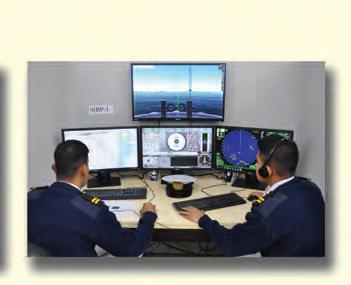
The Academy was founded by the Father of the Nation 'Bangabandhu (friend of Bengal) Sheikh Mujibur Rahman in 1972; commenced a project titled 'Development of Marine Academy 1973' with British Technical Cooperation. Today it is an inventive Academy with opening doors for Female Cadets in 2012, Bachelor of Maritime Science (Honours) Degree under the affiliation of Bangabandhu Sheikh Mujibur Rahman Maritime University (Bangladesh), various coveted international recognitions and research and maritime consultancy for national & international organizations.



Living lonely and working on floating and moving entity for months away from one's family and friends is not an easy task. It needs high level of skills and competence in terms of academic, professional and mental strength. Hence, BMA follows a strategy, for developing world-class Cadets for ocean-going fleet, enriched with Certificate of Competence and Bachelor/Master of Maritime Science degree. The 5,000 alumni are asset of the Country!

Bangladesh Marine Academy ~SHIP
A
for smart young generation Ensures Quality Cadets' entry into seafaring A Maritime Motherland
Graduates are financial contributors
,,, 0.,.:1:,---·
captureallthedataandsupport fromdayoneandgetlostinthe breadthratherthanfocusing.”
Forexample,therewould normallybesomeoperationalKPIs thatarecoretoabusiness–perhaps turnaroundtimeordowntimefor maintenance.Grismansuggests makingsuretheseusecasescan bemeasured.
“Iamnotsuggestingyoudothis beforeyoutalktovendors,butthe businessshouldbeclearwhatthe processesarethatthistwinwill improve.It’saboutgoingthrough theprocessofidentifyingusecases andpriorities,andlinkingback tocoremetricsandthechange inmetricsyouwanttosee.”
Grismansaysitcouldbehelpful tounderstandthatforaproposed twin/systemtobeofanyvalue,it needstogeneratea3%–4%saving inaparticularKPI.“Havingthe knowledgeupfronthelpsyouto understandwhatleveloftooling orsystemitisworthinvestinginto solvethatproblem,andwhatisn’t.”
Itiseasytogetsweptupin digitalisationadventuresbut, aswithanychange,itisstillall aboutthepeople.Itisvitalto havesponsorshipfromsenior
stakeholdersinthebusinessor operationalteamsthatareimpacted byanychanges,saysGrisman.
“Obviously,alotoftheseprojects aredrivenbyITanditisessential thatIT[departments]arepartofthe project.Butunlesstheprojecthas ownershipfromtheteamgetting thebenefit,itisoftenhardtodrive itthrough.Alotoftheseprojects arenecessarilyquitecomplicated andcomplex;ifyoudon’thavethe supportrequired,theywon’tachieve whattheycould.”
Heemphasises,therefore,there willalwaysbeawiderangeofissues onwhichITshouldbeleading,from choiceofcloudplatformtoaligning withothersystems,butitisthe businessthatshouldbedriving theusecases.
Anaturalextension BelgianR&DspecialistInlecom isleadingDigitalTwinforGreen Shipping(DT4GS),aEuropean Commissioncoalitionfocusing onapplyingdigitaltwintechnology totheentirelifecycleofships.

Tothequestion‘wheredoyou start’onadigitaltwinproject,Takis Katsoulakos,Inlecomdirector, replies:“Iwouldsayadigitaltwin ismoreorlessanaturalextension ofwhatyouwouldcalldigital platformsthatshippingcompanies startedusingmoreinthepastfive orsixyears.Thesestartedprobably fromthesamemotivation,as withdigitaltwins,whichisto supportdecarbonisation.
“Shippingcompanieshavefor awhilebeenunderpressureto reportonCO2 andmeetthevarious requirementsfromtheIMO,so theyhavestartedtryingtousemore sensorsandobtainmoredatafrom theirships,analysethemandbegin tousethemtotrytooptimisethe performance.Voyagemanagement optimisationisbecoming particularlypopular–improving overallspeedandarrivingontime, toreducecostsandCO2 aswell.”
Thebigdifferenceindigital twins,hesays,isthelinkbetween thephysicalassetandthetwin, andthetwin’sabilitytomodel
49 MARINE PROFESSIONAL Issue4/2022
“It’saboutgoingthroughtheprocessofidentifying usecasesandpriorities,andlinkingbacktocore metricsandthechangeinmetricsyouwanttosee”
A digital twin must have the ability to model the performance of the asset
KEYFAME VIA SHUTTERSTOCK DIGITAL TWINS >
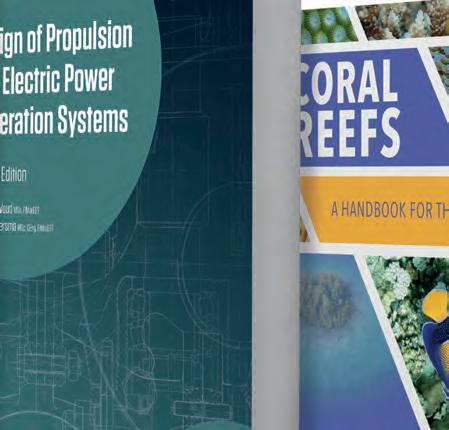




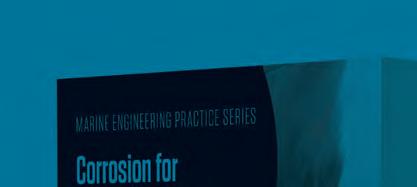
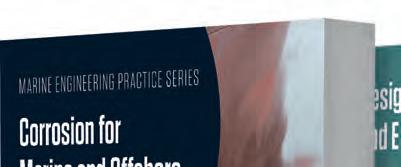
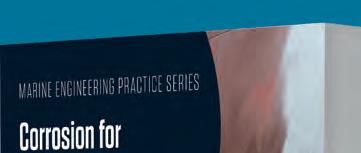










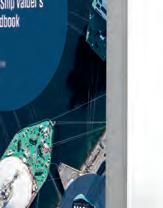













~0%discount acrossallourtitles forIMarESTmembers andMarineMember . companies. www.imarest.org/books
theperformanceoftheassetand, ifthereisadeviationfromthe ‘norm’,tounderstandwhatis neededandactuatesomecorrective actionautomatically.
Fortheshippingindustry
Katsoulakoshighlightstwo importantpointsforcreating effectivedigitaltwins:theaccuracy ofthedatabeingusedandthe typeofmodelemployed.“We aretryingtomoveawayfromthe mathematicalmodelstraditionally usedbynavalarchitectsand engineerstomodelsthatthe shipownercanusefromthestart, includingeconomics,investment andCO2 predictions.”
Ashippingcompanywillnot produceadigitaltwinonitsownbut willlikelyuseaspecialistcompany tohelpthem,hesays.Havingsaid that,largecompanieswillhavetheir owntechnicaldepartmentsthatcan takeonmoreofthework.“Themain thingtheyneedtolookatisprojects likeours–wearetryingtodevelop anopenlibraryofmodelsthatcan beusedbyshippingcompaniesand thewholeindustry.”
Itisimportantfortheindustry tocreateanopenrepositoryof thesemodels,whichshipping companiescanusewiththeir
advisersorconsultants,headds. “Thisissomethingthatmanyof theclassificationsocietieshave beendevelopingforalongtime.
“Thekeyhereisunlessyou createthesetypesofmodelsin astandardisedway,sotheycan beusedbyindustryasawhole, itwillcreateproblemsaswehad inthepast.So,thereareanumber ofinitiativesliketheclassification societies’developmentofopen repositoriesofmodels,which canbeusedfordigitaltwins,and projectslikeoursaswellasprojects forbiggerinitiativeswherewe providethestandardcomponents whichpeoplecanuse,thenthey aredevelopingtheirdigitaltwins.”
Digitaltwinswillultimately supporttheincreaseinautomation andremoteoperationofvesselsand improvesafetyinthewaytaskscan becompleted,saysKatsoulakos. “However,atthemoment,itis moreaboutdecisionsupport.”

Thebiggestprobleminapplying digitaltwinsisthecost,henotes.
“Itisanexpensiveexercisefor ashippingcompanytodevelopa digitaltwin.Eachshiphastohave itsowntwin–it’snotthatyoucan createanddeploythesameoneon allyourships.Eachshipisdifferent. Theaccuracyofthesetypesof modelsisessential,andeverything dependsonhowgoodthedatais. Thatisthebiggestthingyouhave tobecarefulabout–makesureyou haveconfidencethatthemodelsare developedusingtherightdata.”
Heagreeswithtakingthesimple pathfirst.“Forexample,takethe noonreportsandusethemwith yourdigitaltwinandtesttosee ifitpredictscorrectly–sobefore youinstallityouareabletoverify offlinethatitiscorrect.”
Shipdesignprogress
Katsoulakosexpectstoseealot ofprogressinthecomingyearin gatheringmoreevidenceonhow welldigitaltwinswork,howto goaboutcreatingthemandhow toensureyougetthebestsolution inthemostcost-effectiveway. Hebelievescollaborationatclass andIMOlevelshouldleadtoa repositoryofmodels“thatatleast theindustryhasalotofconfidence inusing”.That,hesays,wouldbe abigstepforward.
“Shipyardsrealisetheyare movingtowardsdesigningships withdigitaltwins,andthesedigital twinswillalsohelpinproduction andmanagingthewholelifecycle ofthevessel,linkingbackto equipmentmanufacturersandthe shipyarditselfifthereisaproblem. Thatisthevisionforhowthings willdevelop.Wearetalkingabout retrofittingnow,butinthefuture, digitaltwinningwillbeembedded fromthestart.”
WATCH THIS SPACE
RewatchtheDigitalisation sessionfromthe2022IMarEST AnnualConferenceon IMarESTTVfromJanuary2023.

51 DIGITAL TWINS MARINE PROFESSIONAL Issue4/2022
“Thatisthebiggestthing youhavetobecareful about–makesureyou haveconfidencethatthe modelsaredeveloped usingtherightdata”
Takis Katsoulakos, Inlecom director
A holistic approach to zero emissions
 BY NICK LAMBERT AND GÜRDOĞAR SARIGÜL
BY NICK LAMBERT AND GÜRDOĞAR SARIGÜL
We mariners and practitioners of maritime operations and shipping frequently (and publicly) reflect on our cultural conservatism and wariness of change, bemoaning our slow adoption of digitalisation or our reluctance to address the challenges of climate change. Such vibes are sensed by others to the point where shipping is cited as a laggard or a problem child by experts in apparently more advanced fields. However, having attended the fabulous exhibition at SMM Hamburg 2022 in September, I wonder whether we are unwittingly undermining ourselves?
The first post-Covid SMM was buzzing with professionals delighted to be mixing again with colleagues in halls, conferences and among displays exhibiting the amazing progress that our
maritime and shipping sectors are making in addressing climate change issues such as emissions and the fast-paced development of environmental, social and governance standards. Sail, solar, battery, hydrogen and countless other engineering solutions abounded in the halls; high technology readiness levels were explored, financially viable business models discussed, and regulatory and certification processes were addressed. Understandably, things are not perfect, but it’s clear that our sectors have got the message, can see the opportunities and have actions under way.

Achieving a holistic approach is, of course, very complicated and
far more difficult, but compelling concepts are being developed and, increasingly, they are catching the eye of government, investors, industry generally and shipbuilding specifically. As an example, NLA International is working with the Asia Development Bank on Project MARES (Marine Aquaculture, Reefs, Renewable Energy and Ecotourism for Ecosystem Services). The rather scary anacronym encapsulates a renewable energy-based, holistic approach for states to derive socioeconomic benefit from our ocean while regenerating the marine environment. It’s ambitious and not for the faint-hearted because it’s at the scale needed to address our many global challenges, such as ocean acidification and rising sea levels, while ensuring a just transition for the people of our island and coastal states.
Creating clean energy
There is an increasing number of such innovative concepts. I’m a fan, for example, of the Shetland Islands Council’s Orion Clean Energy Project – a bold vision for an electrification and hydrogen solution that will transform Shetland into a hub of secure, clean, affordable and exportable energy.
The naval architects and engineers at Navtek Naval Technologies in Turkey are on the case, too. The design house behind the zero-emissions electric tug, the world’s first all-electric tug, is now developing the specifications for a ZEEPORT reflecting a client’s desire to reduce port emissions.
MARINE PROFESSIONAL Issue 4/202252
Envisaging a bottom-up plan for the decarbonisation of the maritime sector DECARBONISATION CO2 & AIR POLLUTANTS EMISSION RATES IN PORTS 76% 15% 9% Tugboats Trucks and other vehicles Heavy equipment Achieving a holistic approach is, of course, very complicated and far more difficult, but compelling concepts are being developed
Ferhat Acuner, general manager of Navtek, explained that this corroborates the company’s underpinning vision for a holistic approach to decarbonisation creating net energy-producing ports with integrated, sustainable renewable power-production facilities and, eventually, truly zero-emissions waterborne and portside transportation.
In a thought-provoking presentation at SMM Hamburg, Acuner outlined how the ZEETUG project was born, how it became a flagship product and how its operational performance sparked Navtek’s team to develop a bottomup vision for the decarbonisation of the maritime sector starting with the basics. What are the main polluters in a port, how do they affect public health and contribute to global warming? Navtek’s research revealed that 58%–76% of CO2 emissions and pollutants such as NOx, CHx and PM2.5 and PM10 (particulate matter) result primarily from tugs and other work boats in an average port.
The ZEETUG30 statistics are impressive – over more than two years of commercial operation, annual emissions reductions are 445.9 tonnes of CO2, 1.27 tonnes of NOx, zero PM pollutants and significantly reduced marine
noise pollution. While first-ofclass capital expenditure is higher than conventional diesel tugs, operating expenditure is very favourable, reducing fuel costs by 50% and an almost 80% reduction in maintenance and repair costs. Capital expenditure will of course reduce as production increases. Navtek is also investigating carbon credits for ZEETUGs, which may significantly reduce capital expenditure in the near future.
Incorporating the ports Inspired by the performance of the all-electric ZEETUG, the Navtek team realised that this is just the start of a big change. A holistic strategy is the only way to effectively decarbonise ports and shipping, encompassing port design and operation plus zero-emissions ship designs with alternative fuels and new propulsion technologies, resulting in an inclusive fossil fuel-free solution that fulfils the aim of the Paris Agreement.

Navtek designed a ZEEPORT concept and carried out a costbenefit analysis to demonstrate that decarbonisation of a port is a profitable investment within just over five years. The holistic approach is very broad, spanning greenhouse gas emissions
reduction, public heath, marine and terrestrial ecosystem health including circularity of ship design, construction, operations and decommissioning. Navtek’s Acuner emphasised that “perhaps the most important but often overlooked fact is that zero-emissions ports will avoid many respiratory diseases and the related mortality, which affect the people and economies of port areas”. The ZEEPORT decarbonisation project concept was recently submitted to an international finance institution as a candidate for a green shipping loan.
With apologies to John V4:23, ‘cometh the hour, cometh the technology’ – a holistic approach is certainly possible. We have the technology, we have ambitious holistic concepts, there are clients who want them and companies that can fulfil them. The pace of climate change is such that, arguably, we have no choice: we must work across government and academia industry sectors, overcome our cultural norms, crack on and implement those concepts as soon as possible.
Nick Lambert is co-founder and director of NLA International, and Gürdoğar Sarıgül is climate change and maritime decarbonisation consultant at Navtek.
MARINE PROFESSIONAL Issue 4/2022 53
ZEEPORT & NAVTEK ZEEPORT – CLEANER, GREENER PORTS COMBO GREEN E-CRANES & E-VEHICLES :U:ETUGs QUICK CHARGE STATIONS ----+ WIND TURBINES HYDROGEN PRODUCTION & STORAGE l H2 BUNKER LINE (INFRASTRUCTURE) ELECTRIC BUNKER LINE (INFRASTRUCTURE) COLD IRONING FOR CRUISESHIPS& CARGO SHIPS
The IMarEST’s shared knowledge hub

Putting the deep blue into young minds
imagery corroborated by ubiquitous Automatic Identification System ship-tracking services adorned the front pages as graphics of ships holding off Port Said and Suez.

 BY NICK LAMBERT
BY NICK LAMBERT
For so many, our beaches and coastlines are a hard boundary between land and sea: we walk and play there, enjoy our summers there and perhaps swim, sail or paddleboard there. But only a tiny proportion of the global populace ventures further out to sea.
The majority don’t experience the sheer scale and beauty of our ocean and continental shelf zones; they don’t appreciate the value of our ocean; they don’t realise that it is largely ungoverned; nor do they understand the vital nature of its contribution to our balanced
Two

(albeit increasingly threatened) global climate.
Until recently (other than the 500 million or so people who subsist on fish protein and the roughly 50 million who work in the blue economy), the vast majority of our 8 billion global population did daily business unaware that our ocean is the vital lifeblood of Earth’s environment, our society and the international logistics network that underpins our connected global economy.
Enhancing awareness
I say ‘until recently’, as Earthobservation technologies coupled with eye-catching international events are enhancing public awareness of the import of our ocean and the services it affords us all. MSC’s Ever Given is a starter for one: grounded for six days in the Suez Canal in March 2021, the ship blocked the transit of 50 ships carrying cargoes valued at approximately $10bn – daily Satellite-derived optical and radar
Commentators were enthralled by the fragility of our just-enough, justin-time supply chains and the fact that a mere 60,000 ships transport $14tn of trade value annually.

Ever Given plus Russia’s ruthless blockade of Ukrainian grain ports have indelibly imprinted our social and economic reliance on ocean shipping routes in the public mind.
It’s a similar (and arguably more important) story for the marine environment. Melting ice caps, rising sea levels, ocean acidification, illegal fishing and numerous other environmental challenges are starkly depicted in our living rooms by Earth-observation images from a plethora of satellites. Modern computer-crunching power and geographic information systems coupled with augmented and virtual-reality technologies enable ordinary members of the public to explore and understand our marine and terrestrial environments as never before – revealing what we have done to them and the scary scale of redressive action that is required. Younger generations are increasingly aware of the
54 MARINE PROFESSIONAL Issue 4/2022
On passage, SYF’s young crew members experience the ocean and coastlines… exploring amazing habitats, learning why they are important and understanding humanity’s impact on our marine environment
SEAS YOUR FUTURE, SPILHAUS ARCGIS PRO PROJECT
Raising ocean literacy and awareness is crucial to improving ocean knowledge and making real progress in addressing our marine environment’s challenges and opportunities
young people conducting scientific research on a recent voyage
climate change threat. The UN and numerous other international agencies are engaging, governments are committing to zero-carbon policies and shipping is under enormous pressure to reduce greenhouse gases. An era of ocean literacy has opened.
The study of ocean science

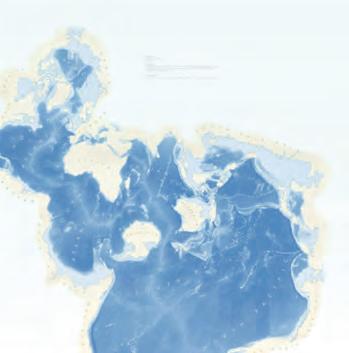

Greater collection of higher-quality climate change data, gathered by the marine science community and enhanced by Earth observation, is driving the development of international and national strategy and policy; scientists are engaging the public more easily thanks to social media and vastly improved communications interfaces. The UN’s Climate Change Conference series and the Ocean Decade initiative are key strategic examples of ocean literacy – evidence that the top-down process is under way.
As IMarEST mariners and marine professionals, it is now beholden on us to drive bottomup ocean literacy opportunities, engaging the public generally and Generation Z specifically, focusing on science, technology, engineering, arts and mathematics
(STEAM) initiatives to create excitement about marine and maritime careers, citizen science and crowdsourcing data collection.

I am therefore honoured to be a trustee of Seas Your Future (SYF), a UK youth development charity offering young people unique development opportunities through sail training and the study of ocean science aboard traditional tall ships. In partnership with universities, schools, other youth charities and social enterprises, SYF enables young people to discover and extend their abilities, values, passions and experience in adventurous, challenging and unexpected environments.

Some 500 young people annually embrace responsibility as STS Pelican of London crew members, communicating and working in teams to fulfil successful ocean voyages, developing their character, resilience, self-confidence, independence and knowledge.
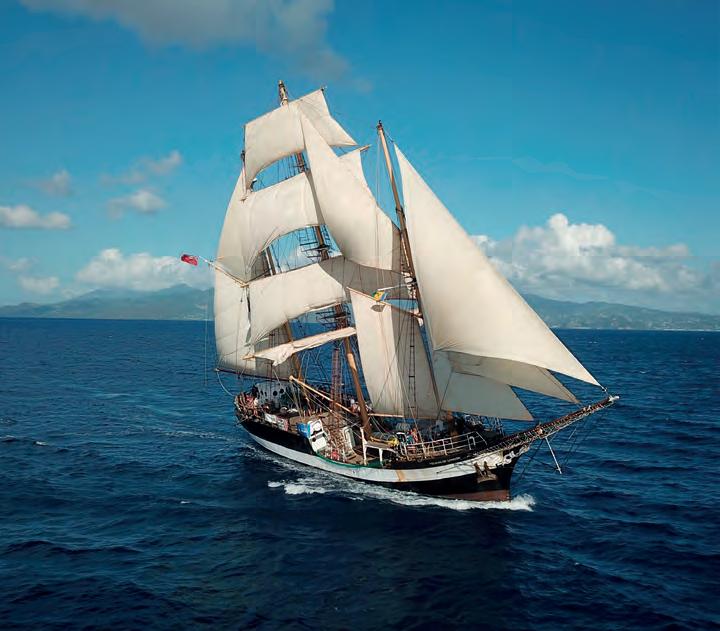
A coastal classroom
Today’s youth is more informed, more aware and rightly impassioned about the environment and Earth’s future. On passage, SYF’s young crew members experience the ocean and coastlines in a way that would not otherwise be possible, exploring amazing habitats, learning why they are important
and understanding humanity’s impact on our marine environment.
Many have never even visited the coast, let alone sailed or seen the life above and below the waves. SYF’s Ocean Science syllabus is mapped to the UK national curriculum enhanced by practical research that is not possible in a formal educational setting. This approach also supports current STEAM agendas. Young people experience STEAM subjects in a practical seagoing context, they appreciate the wide range of marine and maritime industries, and many go on to careers in the maritime and STEAM sectors, their appetites having been whetted. This is an alternative learning platform, providing an exciting classroom for young people who may not be easily engaged by orthodox methods.
SYF’s alumni are ocean literate and return ashore as ambassadors for the ocean; we’re in need of more of them.
Rear Admiral Nick Lambert is co-founder and director of NLA International, a blue economy solutions company. Nick is a master mariner and a committed proponent of the maritime users’ perspective. He concluded a long naval operational career as the UK National Hydrographer in December 2012.

55 MARINE PROFESSIONAL Issue 4/2022 In this section: 54 Ocean science education 56 Fellow Q&A: Mike Watt 59 IMarEST Branch spotlight 60 SIG update 63 Comment: member survey 65 Institute news
Sail training ship Pelican– SYF plans to increase capacity to approximately 1,000 young people annually following the purchase and refit of a new sailing training ship
Map of the world’s oceans --
“I found being a technical superintendent quite an adrenaline rush”

trips on-board Stolt Tankers. On my last trip as a supernumerary in 1997, I was given the opportunity by the second engineer to have some handson interaction with the engine room equipment. This sparked my interest in marine engineering and a goal of completing my GCSEs to achieve the requirements for a cadetship.
How did your career evolve from marine engineering to business and projects development?
draw on previous experience, knowledge and certainly a large amount of out-of-the-box thinking. Clear communication with all stakeholders in this role was absolutely essential, as well as empathy with the personnel sailing on-board the vessels who were putting in the maximum effort and had pride in their profession, even throughout the pandemic.
BY CARLY FIELDS
How did you first get involved in the marine industry?
I come from a rather long line of seafarers, both navigational and engineering, on both my mother’s and father’s side. My father sailed up to the rank of master in Stolt-Nielsen on chemical tankers until coming ashore in 2004; he is now the general manager at Stolthaven New Orleans.
My grandfather was also at sea, working his way through the ranks to master and coming ashore to finish his career as marine director for Sealink/Stena Line ferries. His father was also at sea. My mother’s father worked for Exxon as a marine engineer, coming ashore when he was second engineer and my great-grandfather was a master mariner with RFA and Eagle Oil. I myself sailed often with my mother and father when I was growing up, exploring the world during many
Working for BP Shipping presented me with amazing opportunities to understudy those senior to me as well as the sharing of information, which was very common in the fleet. BP had a slogan: ‘This is what good looks like’, which was not something I really appreciated until later in my career when coming ashore and carrying out pre-purchase/premanagement inspections on vessels.
In 2017, I was offered the chance to make a move to Singapore and become technical superintendent with a ship manager. It was an adventure my nomadic family was fully behind and so I started my shoreside career in Singapore.
I found being a technical superintendent quite an adrenaline rush, moving from one emergency to another, constantly having to
Earlier this year, I joined ASP Ships Group as business and projects development manager, which is quite different from my previous role as technical superintendent in the way that I no longer deal directly with vessel issues. In this position I depend on my ability to communicate effectively with clients and other stakeholders through different channels as well as relying on my technical background to formulate vessel-operating expenses, advise on innovative technologies including fuel efficiency/decarbonisation and develop new systems and processes to improve the company offering and secure new business.

Much of this evolution in my career can be attributed to the benefits of membership of the IMarEST, having been a member since 1998. Being a member of the

56
IMarEST Council member and Branch chair Mike Watt on the excitement and the challenges of the marine industry
“Much of this evolution in my career can be attributed to the benefits of membership of the IMarEST… Being a member allows you to be part of a large community of professionals with similar interests, and a passion and pride in what they do”
MARINE PROFESSIONAL Issue 4/2022
IMarEST allows you to be part of a large community of professionals with similar interests, and a passion and pride in what they do. Using the CPD allows you to focus on what your aims are, what you need to do to achieve those aims, what resources/additional training will be required and a time frame for you to complete your goals.
What is the most noteworthy change that you have experienced over your 24 years as a marine engineer?
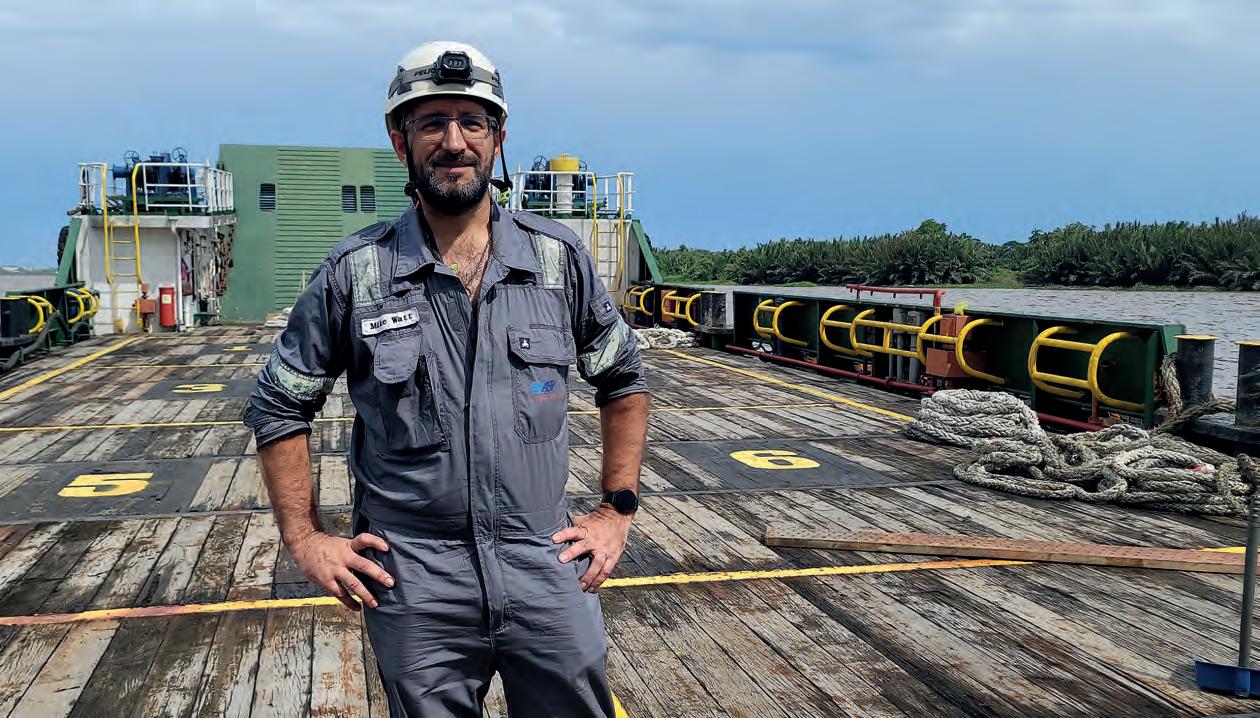
For me, the most noteworthy change would have to be the improvement in communications and data transfer from vessels, whether this is the ability of seafarers to communicate with their friends and family when far away from home or the IoT that we now see being adopted across vessels.

It includes seeing the technology improve from a simple desktop computer with email functionality that would send email through the Captain to now being able to use on-board Wi-Fi of varying quality. When looking at the data that can be received from vessels now assisting the ship staff in their daily activities and giving realtime oversight of the vessel to ship managers and operators, this is only

just the beginning of the evolution of ship operations with digital tools as we move towards different ways of managing vessels with increased automation and connectivity.
From the projects that you are currently engaged with, which excites you the most?
I have been working on several projects this year, which all integrate into one major project as part of ASP Ships Group’s digital offering to our customers. I would say that the exciting side of it for me is the brainstorming, designing and bringing everything together.
I get to speak to many vendors and entrepreneurs about their products and think about how this can be
used to the benefit of our company and our customers. It’s all about making life easier for everyone involved and having products that truly allow us to do our work better on-board vessels and in our offices.
What challenges and opportunities do you see on the horizon for marine engineering?
Obviously, the major challenges which are here with us right now are with regards to the emissions targets. Some of the biggest questions for those planning to build ships is what technology to include, how to future-proof them and what fuel will have the best availability. Nobody wants to be in the position where they purchased an HD DVD player only to see Blu-ray be the winner and most adopted solution – I could have referenced Betamax, but that might be too far back for some to remember. With these challenges, though, of course come opportunities to learn new skills, work with different equipment and be involved
57
Marine Conference 2022 during a nuclear talk
FELLOW Q&A
“It’s all about making life easier for everyone involved and having products that truly allow us to do our work better on-board vessels”
Mike Watt on the main deck of landing craft during trials
MIKE WATT
MARINE PROFESSIONAL Issue 4/2022 >
inexcitingprojectswithdual-fuel engines,fuel-efficiencyhardware andvessel-performancesoftware analysingthedataandactingonit.
Whatisinvolvedinyourroleas aCouncilmemberoftheIMarEST andwhatareyourprioritiesfor yourtimeontheCouncil?
IrecentlyjoinedtheIMarEST councilasanAppointedMember andattendedmyfirstmeetingin July.Iamoneoftherepresentatives fromtheAsia-Pacificregionand servealongwiththeothermembers inanadvisorycapacitytotheBoard ofTrusteesaswellasbeinginvolved withtheprofessional,technical andlearnedsocietyaffairsofthe Institute.Myprioritieswouldhaveto beimprovingthecommunications betweentheBranchesandthe Council,specificallyinthisregion [Asia],andthisissomethingthat weareworkingonsothatthegears arewelllubricatedandmeshing togethertoproducethebestresults forallthemembersoftheInstitute.
Whatisinvolvedwithyour roleasSingaporeJointBranch chairandwhatarethegoalsfor yourtenurethere?
Icameintotheroleofchairmanin themiddleoftheCovid-19pandemic attheendof2020,withmany restrictionsinplace.Ihadbigplans attheoutsetandwasoptimisticthat thingswouldeaseoffconsiderably atthebeginningof2021.However, itendedupthat2021wasverystopstartandextremelyfrustrating.
ItwasonlyinAprilthisyear thatwehavebeenabletoreally starttodothingswiththeallowed numberofpeoplearoundatable increasing,limitsbeingremoved andthequantityofattendeesfor eventsallowedtoincreaseabove 50.Wetooktheopportunitywhile itexistedtohavetheMarine Conference2022onClimate ChangeandRisingSeaLevelsin June,whichwassuccessful.Itwas greattomeetpeopleagainand talkaboutinterestingtopicsina physicalsetting.Inthefinalmonths
ofmytenure,Ilookforwardtoour hostingthe20thAnniversaryDinner Conversazione,whichmarks20 yearssincetheformationofthe JointBranchofRINA&IMarESTin Singapore;itwillbeheldatRegent HotelSingaporeon4November (ticketsareavailableonEventbrite).
Whatareyoumostexcitedabout inthefuture,andwhatisthe biggestchallengefacingthe marineindustry?
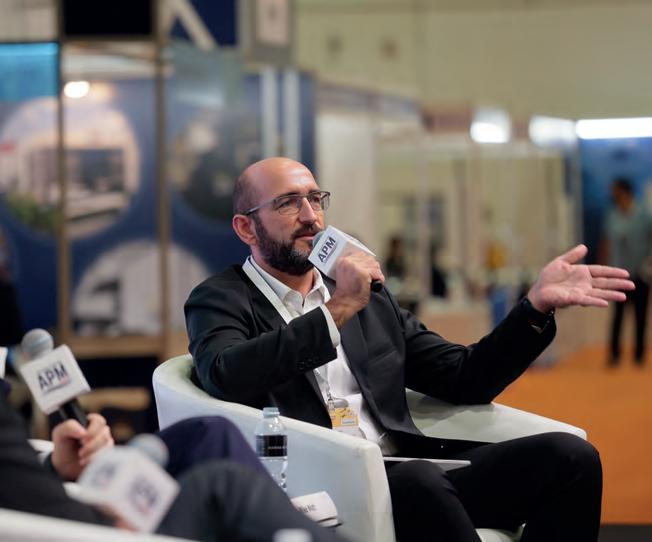
Themostexcitingthingsformeare seeingthenewinnovationsbeing developedandtestedinthemarine industry–tohavetheopportunity tobeinthisindustryduringthese interestingtimesisquitefantastic.
Overthenext20years,wearegoing toseecommunicationwithvessels becomeseamless,andreductionin themanningofvesselsasautomation evolvesandasartificialintelligence isinvolvedmoreandmoreinthe differenton-boardprocesses.Isee
ABOUT MIKE WATT
therolesofthoseon-boardand ashoreadaptingasthetechnology evolvestowardssemi-autonomous andautonomousvessels,andit’svery interestingtoseehowopen-minded manyareaboutwhattheirrole wouldbewiththesetypesofvessels astheybecomemorecommon.

Idothink,though,thatoneof thebiggestchallengesisgoingto bemaintainingvalueforcustomers withmoreregulationsonthe horizonandcompanieshaving tocontinuouslyprovetheir environmentalcredentials.The marketsareturbulentandwhere somehavedonewellinthepast fewyears,othershavenotbeen aslucky.Investmentisrequired tomeetsustainabilitygoalsand Ithinkthiscanonlybeachieved throughcollaborationandjoint venturesforacommoncause.These areinterestingandexcitingtimes, whereIoftenfeelthattheonly limitingfactorisourimagination.
MikeWattMScIEngIMarEngMIMarESTisbusinessandprojectsdevelopment manageratASPShipsGroupinSingapore,aCouncilmemberfortheIMarEST, andchairmanoftheSingaporeJointBranch(RINA&IMarEST).Previously, hewastechnicalsuperintendentatNorstarShipManagementPteLtd,held anumberofengineeringrolesatBPandwasamarineengineerofficerat Stolt-NielsenLimited.HehasanMBAandanMScinEngineeringforMarine ProfessionalsfromtheUniversityofPlymouthandcompletedhisCertificate ofCompetency–ManagementLevelsIII/2atSouthShieldsMarineSchool.

58 FELLOW Q&A
“Themostexcitingthingsformeareseeingthenew innovationsbeingdevelopedandtestedinthemarine industry–tohavetheopportunitytobeinthisindustry duringtheseinterestingtimesisquitefantastic”
MIKE WATT
On the Autonomous Shipping Panel at Asia Pacific Maritime 2022
MARINE PROFESSIONAL Issue4/2022
On a path of evolutionary continuous improvement
BY CARLY FIELDS
Pleasedescribetheregionthat yourBranchcovers.
Ourregionhasanillustrious industrialtraditionofheavyand lightengineering,andisknown worldwideforbothinnovationand quality.However,manufacturing isnowlessprevalentandhence theregionisperceivedasless prosperousduetothereduction inassociatedhighlyskilledjobs. Wehaveanenviableheritage, butthereisnowaskillsgap emergingtogetherwithan associatedlossofindustry‘corporate memory’,whichisunfortunately anissueglobally.
Whatinterestsdoyour membershave?
Ourmemberscoverawiderange ofmaritimeinterests–fromship designandconstruction/repair, marineengineering/enginebuilding andmaintenance,andequipment manufacturersandsuppliersto offshoreoilandgas,offshoreenergy andrenewables,andmarinescience researchandadministration.We alsohavemembersfromshipowners andoperators,portoperations, aswellasfromworld-classhigher andfurthereducationinstitutions. Therefore,wehaveastrong maritimestudentandresearch baseencompassingnaval architecture,marineengineering, shipoperations/navigation,offshore engineering,small-crafttechnology andmarinescience.

Whateventwouldyouhighlight fromyourprogramme?
Nooneeventstandsoutabove others,butrathertheextent, breadth,depthandqualityofboth thelast(2021–22)andtherecently

commencedsessions(2022–23)stand out.Wehaveanenviablerangeof 14annualtechnicalmeetingevents, allofwhichareselectedtomaximise contributiontomembers’continuing professionaldevelopment(CPD), andthislargenumberofmeetings ensuresthatwehavetheabilityto offeradiverserangeofpresentation topicstomembersandguests fromcutting-edgeinnovationto historical.Stimulating,searching andinterestingpost-presentation discussionsareactivelyencouraged, astheseaddsignificantlytothevalue ofeachpresentation.Inaddition, oursocialeventsaredesignedand coordinatedwithotherstomaximise theexposureoftheBranch–and henceIMarESTandRINA–to thewiderengineering,technical andscientificcommunitiesinour region.Theyalsoactascatalyststo bringboththeexistingandmore disparate/uninvolvedelementsofthe engineering,technicalandscientific communitiestogether.
Whatplansdoyouhaveforfurther developmentoftheBranch?
Wearearguablyoneofthe mostsuccessfulbranchesof eithertheIMarESTorRINA, andhenceweoperateasystem ofcontrolled‘evolutionary’ continuousimprovement,rather than‘revolutionary’change.In 2023,weshallcontinuetoprovide CPD,learningandnetworking
opportunitiesformembersand otherinterestedpartiesthrough ourextensivetechnicalandsocial programmeofeventsandthrough workingcloselywithotherlocal engineering,technologyand scientificengineering-based learnedsocieties.Threeexamples ofthisare:
l ParticipationwithEngineeringUK andtheNorthEastCommunity ofProfessionalEngineersin organisingeventsforyoung peopleandthedissemination oftechnologyandengineering tothewidercommunity;
l Ourrecentlyinitiatedseriesof jointlectureswiththeNewcastle uponTyne-basedNorthof EnglandInstituteofMining andMechanicalEngineers (NEIMME);and
l Ourcloseworkingrelationship withtheNorthEastMarine Professionalsgroup.
Lookingahead,weareworking closelywiththemarine,offshore andsubseatechnologygroup withintheSchoolofEngineering atNewcastleUniversitytodirectly ‘inject’practicalknowledgetothe existingacademicsyllabusthrough ourtechnicalprogramme.
Wehavealwaysencouraged studentparticipationinourBranch andhenceweco-optthechairsof theIMarESTandotherstudent sectionsontoourcommittee.
KeithHutchinsonBEng(Hons)CEngCMarEngFRINAFIMarESTFSNAME
FNEIMMEishonorarytreasurerfortheNorthEastCoastJointBranch(NECJB), aseniorconsultantinwholeshipdesignandnavalarchitecture,andheadof professionaltechnicalandengineeringservicesatSafinahGroup.TheNECJB representsapproximately1,500membersofboththeIMarESTandRINAin theNorthEastofEngland.TheNECJBwasformedinMarch1953astheNorth EastCoastSectionof,thethen,InstituteofMarineEngineers(IMarE)and celebratesits70thanniversaryin2023.FormoreinformationontheBranch, gotoimarest.org/local-communities/uk/north-east-coast-joint
59 MARINE PROFESSIONAL Issue4/2022
KeithHutchinsonoftheNorthEastCoastJointBranchexplains howpartnershipsarecriticaltobranchdevelopment
BRANCH SPOTLIGHT
Where biology and chemistry collide
BY JOHN LEWIS
Through the history of life on Earth, the distribution of species has changed as species expand their range in response to biological and environmental factors that facilitate population survival and growth beyond initial boundaries. This spread is similarly constrained by biological and environmental factors but, often more importantly, geographic and climatic barriers. That modern humans found means to travel across these barriers enabled both the intentional and accidental movement of species by these people. Domesticated animals and edible plants accompanied the human colonisers, but so too did biological hitchhikers.
The majority of introduced non-indigenous plants and animals cause little harm, but some do become invasive which, by definition, is the subset of exotics that cause harm to the environment, economy, social values or human health. There are many examples of the latter in terrestrial and freshwater environments, for example, the European rabbit and common carp in Australia, but few
in the marine realm. The spread of toxic microalgae within ballast water is one significant example, with consequences including fish kills and even human death from paralytic shellfish poisoning.

Marine biofouling
But what about the myriad of biofouling species that are continuously shipped around the world on vessel hulls, and have been for centuries? The one major census of biofouling species, by the Woods Hole Oceanographic Institute in 1952, listed close to 2,000 marine biofouling taxa. Of those, around 400 were found on ships. More than 170 invertebrate species were recorded in a 2010 survey of 270 merchant ships arriving in New Zealand. Despite this apparently extreme invasion pressure, documents of the adverse impacts to the recipient environments are few. Why?

The marine biofouling community is one that has developed over the centuries that ships have been traversing the oceans between many ports.



Biofouling species are opportunistic species that have high reproduction and fast growth rates that enable them to rapidly colonise on any available substrates. However, they are commonly short-lived and poor competitors to larger, slowergrowing benthic species.
When biofouling species establish in new locations, they are restricted to newly immersed or exposed surfaces or to disturbed environments, and these are common within ports, harbours and marinas. The long lists of non-indigenous marine species attributed to arrival as biofouling on international ships are almost always collected in these artificial environments.
Barnacles growing on the hull of a ship
A tenet of biological species dispersal is that species tend to move from areas of high biodiversity to areas of low biodiversity. In relation to ship biofouling, this is reflected at both ends of the ship’s voyage: at the departure port as species from the local ecosystem colonise a sparsely colonised ship hull, and at the destination port where the hitchhiker releases propagules
MARINE PROFESSIONAL Issue 4/202260
There is a need for clear priorities for biofouling management on international vessels

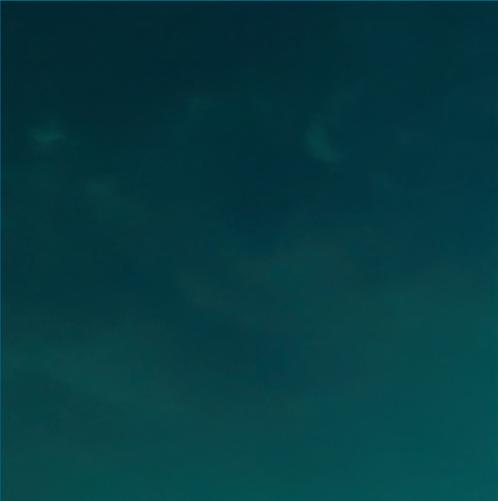
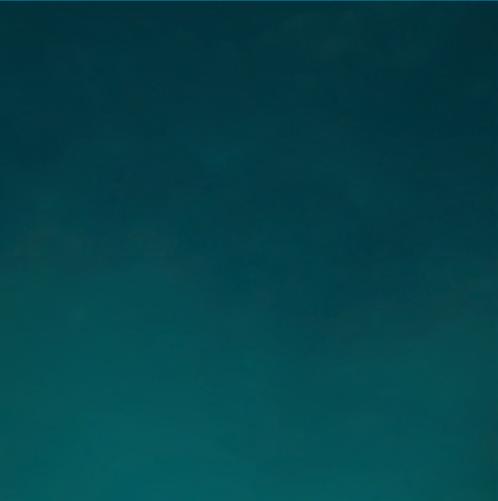
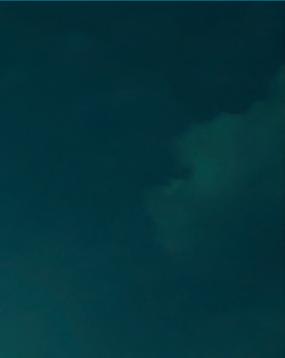


.::!::;._.;.. ...
COMMENT
Working together to beat the skills gap

MEMBER SURVEY
ByGwynneLewis
Peopleandskillsemergedas oneofthethemesinIMarEST memberresponsestothequestion: ‘Whatdoyouthinkarethegreatest challengesthatwillimpactyour sector/areaofexpertiseintheshort-, medium-andlong-termfuture?’ Morethan700membersresponded, andtheresultsfeatureinanew reportavailableonourwebsite.
Theskillsgapinthemarine sectorisachallengeraisedbymany members,whoexpressedconcerns aboutanageingworkforce,theloss ofexpertiseandtheneedtoattract youngtalent.Thesectorisnotalone infacingthisissueandcompetition fortalentedpeopleishigh.To compete,themarinesectormust beattractivetonewtalentfroma diverserangeofbackgrounds,retain itsexistingexpertiseandretrain peoplewherepossible.Itneeds thecollectiveeffortofeveryone involvedfromacademia,employers, individualsandbodieslikeourown.
Foremployers,retainingexisting expertiseisinvaluableandthereare variousstepstheycantaketoachieve this,fromprovidingtransparency aroundprogressionopportunities andencouragingcontinuing professionaldevelopmentto providingsecondmentopportunities




thatallowindividualstoexperience newchallengesandlearnnew skills.Employerscanalsosupport individualsintheirprofessional developmentbysponsoringorpaying formembershipofprofessional bodiesand,whereappropriate, encouragingindividualstowork towardstheirCharteredstatus.
Takingadvantageofopportunities forprofessionaldevelopmentisvital forallofus.Itallowsustokeepup todatewithnewknowledge,skills orcapability,makesourjobsmore enjoyable,opensupnewcareer options,helpsourorganisations becomemoresuccessfulandequips ustobecomegoodrolemodelsfor thenextgeneration.
Enticingnewtalent
Aswellasretainingexpertise,we needtobuildapipelineoftalentby inspiringyoungpeopletowantto workinthecutting-edgerolesthat areemerging.Goodrolemodels arevitalinthisandhelptoshow studentswhat’sinvolvedinasector thatthey,theirparentsandteachers mayknownothingabout.
Employersandrolemodelscan notonlyprovidein-depthinsight intotheirprofessionbyworking withlocalschools,collegesand universities,butalsogivestudents theopportunitytogetinvolvedin real-lifeprojects,offercompetitions, workexperienceandpotentiallyfind theirfutureemployer.




Buildingthepipelineviaeducation isalong-termstrategyforthesector, butwealsoneedtoembrace shorter-termoptionsandwiden ourtalentpooltofilltheskillsgap. Wehavearealopportunitytoattract peoplewithrelevantexperience gainedindifferentsectors,and welcomethosewhohaveaSTEM backgroundandwanttoreturnafter acareerbreak.Themarinesector canlearnfromothersectorsthat aretakingthisapproachandoffer opportunitiesforindividualsto transfer,return,retrainorupskill. Keyinallofthisisrecognisingthe importanceandvalueoftransferable skillsandexperience.
GwynneLewisischiefexecutive oftheIMarEST.VisittheIMarEST websitetoreadthefullreport.

63 MARINE PROFESSIONAL Issue4/2022
Themarinesectormustimproveits attractivenesstonewanddiversetalent
“Wehaveareal opportunitytoattract peoplewithrelevant experiencegainedin differentsectors”
IGOR BATENEV
Marine sector employers and role models can offer work experience to students
Your Institute
Through a series of webinars on IMarEST TV, members and Fellows can benefit from a wealth of knowledge on possible solutions to climate change and the impending rise of sea levels in decades to come.

The webinars together form the Joint Branch of RINA & IMarEST (Singapore)’s Marine Conference 2022, Climate Change and Rising Sea Levels. Throughout the sessions, experts discussed what technologies can be used to slow the rate of climate change and deal with potentially reduced landmasses.
The topics covered included carbon capture, floating farms/cities/ renewables, nuclear technologies and decarbonisation.
Mike Watt, chairman of the Singapore Joint Branch, gave the opening remarks, leading into the first session on climate change. The second session focused on decarbonisation in shipping, with presentations on challenges and opportunities in the industry, the potential use of methanol as a shipping fuel, and the status and outlook of other
alternative shipping fuels. The third session looked at floating solutions to contemporary challenges, while the final session featured presentations on nuclear power and its uses in the marine sector.
IMarEST Branch webinars


Elsewhere, the North East Coast Joint Branch hosted a webinar on Ammonia Fuelling of Vessels, exploring the application for the use of ammonia and the challenges to its supply. Speaker René Sejer Laursen, global sustainability director of ABS Copenhagen, presented existing rules and
regulations around ammonia in the maritime sector, combustion principles, production aspects and costs, as well as other logistical and technical aspects related to the industrial use of ammonia.

The South East England/London Home Counties Branch turned its focus to Floating Offshore Facilities for the Hydrocarbon and Renewable Industries for its latest webinar. A group of four interlinked presentations were given by industry experts who discussed the latest design, construction and operations of offshore floating facilities and systems.
On the naval front, the IMarEST’s Naval Engineering Special Interest Group welcomed FutureNEST, the young professional arm of UKNEST, with its presentation of the outputs of a six-month campaign to workshop a Future Autonomous Fleet for the Royal Navy. FutureNEST’s imaginative imagery encouraged a broad public discussion that ranged from which sci-fi film they closest represented to the major operational benefits that could be accrued should they be incorporated on existing platforms.
64 MARINE PROFESSIONAL Issue 4/2022
What’s new on IMarEST TV?
●
View lectures, conferences and webinars at imarest.org/tv
FutureNEST presented the outputs of a six-month campaign to workshop a Future Autonomous Fleet for the Royal Navy The latest initiatives and member benefits
from the
IMarEST THE IMAREST ,='::::::::-::---=:: ~~-· ~· ---~--v -=..=:. -,::;II~-,-, _____ _ ~, -Ml_.,,_ --~.
News in brief
New marine mammals careers guide
The IMarEST Marine Mammals Special Interest Group (MMSIG) has released a comprehensive careers guide to appeal to both students and employers. It shows students the types of roles they could aspire to, but also provides employers with a valuable insight into the difference between the many specialist roles to enable them to understand and recruit individuals with the right skills for their projects. The guide includes ‘role model’ case studies and commentary from real professionals in these roles as well as listing the types of activities each job typically involves, and the skills and experience needed for that job.
The Marine Mammal Careers Guide is the latest in the IMarEST’s resources, which aims to promote marine professions and support those working in the sector.
If you want to get involved in our efforts to support marine mammal conservation and marine scientists in the industry, register your interest in becoming a committee member by contacting technical@imarest.org. You can get involved with the group’s activities by joining either as a corresponding member or, if you are advanced enough in your career, as a committee member, to start influencing the profession at a higher level.
If you are a member of another Special Interest Group, you may consider developing your own careers guide in that field to support the next generation of marine professionals.
Challenges in the Marine Industry: 2023 and beyond
The Institute published a new report that identifies the skills gap as one of the major challenges the marine sector faces over the coming decade. The report is based on short-, medium- and long-term challenges identified by more than 700 IMarEST professional members in a survey. Responses show that concerns broadly align along the themes of people (skills), technology and the environment.
● Read more about the report on page 63
Awards assessors
DIARY DATES
8–10 NOVEMBER
International Naval Engineering Conference and Exhibition 2022, Delft, Netherlands
8–10 NOVEMBER
International Ship Control Systems Symposium 2022, Delft, Netherlands
31 MARCH
118th Annual Dinner, London, UK
The Institute offers a broad range of awards, grants and funding.


We are looking for members from a wide range of backgrounds to help assess applications and sit on the judging panels for a variety of these awards. The roles are flexible, can be done mostly at your convenience, rather than a fixed time, and should require only a few hours of your time a year.
● If you would be interested in taking on a role like this, email awards@imarest.org
Artificial Intelligence Special Interest Group
The IMarEST is hoping to launch a new SIG on the topic of artificial intelligence (AI). If you have experience or an interest in AI and would like to be involved in driving progress in this field, let us know. As well as participants, we are looking for committee members who can help lead the direction of this SIG. If you are interested in becoming a committee member, email technical@imarest.org with some information about your professional experience in this area.
Kevin Tester Award for Marine Journalism
We welcome submissions of articles published in 2022 for next year’s award. The Kevin Tester Award for Marine Journalism recognises the work of a journalist or team of journalists for exemplary reporting relating to a marine or maritime issue. The award, which aims to identify and encourage highquality coverage of marine or maritime matters to bring about constructive change, increase public awareness and improve understanding, will recognise a distinguished example of explanatory reporting, editorial writing or feature writing.
The winning piece should stand out for its originality and demonstrate mastery of the subject and clarity in writing. The piece may illuminate a significant and complex subject, offer an argument powerful enough to sway public thought in a technically or scientifically sound direction, or inspire significant debate within the industry or wider public.
● Read the criteria and submit your own piece or nominate someone else here: tinyurl. com/rkv3uhae
65 INTERACTIONS MARINE PROFESSIONAL Issue 4/2022
2023
BY CARLY FIELDS
Whatdoesyourcurrent roleinvolve?
Mytitleis‘innovator’,whichwas suggestedbymyassistant,when Ipassedthechairroletomydaughter. So,Icomeupwithanewproduct idea,makeamulticolouredsketch, machineaprototypeinmyhome shop(ifpossible)andthenofferit forconsiderationtoourengineers. Istartedwiththecompany,founded bymygrandfather,in1965.Myfirst realmarinechallengewasbringing backtolifethe94ftsteamyacht Wanda111builtin1914forLady Eaton.Itwastobecomemyfloating summerhomefor20years.Ilearned alotrestoringandsailingit.
Whatfirstinspiredyoutoget intothemarinesector?
MyunclewasheadofShellCanada andthatinvolvedmanagingitsfleet oflake-basedtankers.Iwasmaybe sixyearsoldwhenhetookmeinto thewarmengineroomoftheRiver ShellwinteringinToronto.Ifellin lovewiththemachinery.Ididn’t knowitthen,butthatwasreally whereitallstarted.
What’sthemostimportantlesson you’velearnedinyourcareer?
Weallmustdoeverythingpossible tosaveourplanet.Ourbusiness, ThordonBearings,makesbearings andsealsformarineapplications, andstandingbyourpledgetomake orsellnothingthatcanpossibly polluteourwatershasmeant walkingawayfromopportunities tosellwheretheremightbeany possibleriskofleakage.Toturn
downbusinessbasedonprinciple ishardtodosometimes,butit’sthe rightthing.Itcamefrommymother, whowasanenvironmentalistbefore thewordwaseverpopular.
Wheredoyouseeyourcareer goingoverthenext10years?
I’mnotevensureI’lllast10more years,butifIdo,I’llspendittrying todothingsthatmakethisworld abetterplace.Makingmoneyisa necessitytobusinesssurvival;itis absolutelynotourfundamentalgoal.
Whatadvicewouldyouoffer tosomeoneinterestedin pursuingamarinecareer? Themorevariedtheexperiencesthat youcanexposeyourselfto,themore valuableyourcontributionwillbe. Havingeitherdeckorengineroom timeatseaisinvaluable.Youlearn alotaboutwhat’sneededforsurvival underdifficultconditions.Italso exposesyoutoopportunitiesfor newproductdevelopment.
Forexample,inmysea-going worldIhadtodealwithshaft-sealing problemswhileatsea.Thisledto thedevelopmentoftheSeaThigor seal,oneofthemostvaluable innovationsThordonhasintroduced. TheThomsonSternSpace(TSS), astern-tube-lessshipdesign,came fromunderstandingthedifficulty shipyardshadinsuccessfullycoating theinteriorofsterntubes.ThisTSS designeliminatesthesterntubeand theshaftrunsinsidethecooling watertank.
Inamoreradicalevolution,the wholeafterbodyspaceisdryand thepropellerbearingandsealare combinedinasinglewater-lubricated assembly.Itallowsgreatercargo spaceandtheenginecanbelocated furtheraft.Experiencingfirst-hand frozenjointsondeckequipmentled toourdevelopmentofgrease-free fairleads,roperollersandwinch bearings.HadInothadthose14years ofexperienceatsea,Iwouldnot haveknownwhattheindustryneeds.
George(Sandy)
Thomsonisfounderof ThordonBearings.He wasawardedtheElmer ASperryAwardin2019.

66
“The more varied the experiences you expose yourself to, the more valuable your contribution will be”
THE BIG QUESTIONS
MarineinnovatorGeorge(Sandy)Thomsonexplainswhyonly hands-onexperienceatseacanprovewhattheindustryneeds
“Toturndown businessbasedon principleishardto dosometimes,but it’stherightthing”
MARINE PROFESSIONAL Issue4/2022
CREDIT: SANDY THOMSON, THORDON BEARINGS


















































' •;,){' ~f".,,...,,i . ~·, .. < ~1~; Y., .-,:~i.J.~<.\_.

























































 BY CHARLIE BARTLETT
BY CHARLIE BARTLETT

















 BY JOHN BARNES
BY JOHN BARNES











 RichardPerryCEngFIMarEST chiefengineer,Atkins–memberoftheSNC-LavalinGroup
RichardPerryCEngFIMarEST chiefengineer,Atkins–memberoftheSNC-LavalinGroup


































































































































 DIGITAL HISTORY, THE IMPERIAL COURT, LIBRARY OF CONGRESS
DIGITAL HISTORY, THE IMPERIAL COURT, LIBRARY OF CONGRESS







































































 BY NICK LAMBERT
BY NICK LAMBERT






































































